['Species Protection']
['Endangered Species']
03/13/2024
...
(a) Manatee sanctuaries. The following areas are designated as manatee sanctuaries. All waterborne activities are prohibited in these areas during the period November 15-March 31 of each year. The areas which will be posted are described as follows:
(1) That part of Kings Bay, Crystal River, Citrus County, within T. 18 S., R. 17 E., Tallahassee Meridian; located in SW 1/4 fractional section 28, more particularly described as follows:
Beginning at Corner 1 (N-1,653,459/E-308,915) Florida Coordinate System, West Zone, a point on the shoreline of Kings Bay near the southwest corner of Lot 9 as accepted on a plat by the Department of the Interior, General Land Office, dated January 10, 1928; thence easterly, along said shoreline, approximately 1240 feet to Corner 2 (N-1,653,762/E/309,641) a point; thence S. 56�58?11? W., across open water, 776.49 feet to Corner 3 (N-1,653,339/E-308,990) a point; thence N. 32�03?07? W., across open water, 142.26 feet to the point of beginning, containing 3.41 acres, more or less, to be known as the Banana Island Sanctuary.
(2) That part of Kings Bay, Crystal River, Citrus County, Florida, within T. 18 S., R. 17 E., Tallahassee Meridian; located in SW 1/4 fractional section 28, more particularly described as follows:
Beginning at Corner 1 (N-1,652,684/E-309,396) Florida Coordinate System, West Zone, a point on the shoreline of Kings Bay, said point being the northwest corner of Lot 31 Sunset Shores Addition to Woodward Park (Plat Book 2, page 140 Citrus County Property Appraiser's Office); thence N. 35�05?33? W., across open water, 439.10 feet to Corner 2 (N-1,653,043/E-309,144) a point; thence N. 67�23?28? E., across open water, 873.45 feet to Corner 3, a point on the shoreline of Kings Bay said point also being a corner in the northerly boundary line of Lot 21 in said subdivision; thence southwesterly along said shoreline and the northerly boundary of Lots 21-31, including a canal, approximately 920 feet to the point of beginning, containing 5.62 acres, more or less, to be known as the Sunset Shores Sanctuary.
(3) A tract of submerged land, lying in Sections 21 and 28, Township 18 South, Range 17 East in Citrus County, Florida, more particularly described as follows: All of the submerged land lying within the mean high water line of a canal bordering the western, northern, and eastern sides of Paradise Isle Subdivision, as recorded in Plat Book 3, Page 88 of the Public Records of Citrus County, Florida; bounded at the western exit by a line drawn between the southwestern corner of Lot 7 of said Paradise Isle Subdivision and the southeastern corner of Lot 22 of Springs O'Paradise Subdivision, Unit No. 3, as recorded in Plat Book 3, Page 70 of said Public Records; and bounded at the eastern exit by an easterly extension of the south boundary of said Paradise Isle Subdivision; Containing 3.4 acres, more or less, to be known as the Magnolia Springs Manatee Sanctuary.
(4) A tract of submerged land, lying in Sections 28 and 29, Township 18 South, Range 17 East in Citrus County, Florida, more particularly described as follows: For a point of reference, commence at the southwest corner of said Section 28; Then go N 06�01?23? W for 4466.90 feet to a 10-inch diameter concrete monument marking the Point of Beginning; Then go N 10�05?38? W for 477.32 feet to a 10-inch diameter concrete monument with an attached buoy; Then go N 37�34?41? E for 651.07 feet to a 10-inch diameter concrete monument with an attached buoy; Then go S 73�26?46? E for 634.10 feet to a 10-inch diameter concrete monument with an attached buoy; Then go S 17�50?16? E for 1691.53 feet to a 10-inch diameter concrete monument with an attached buoy; Then go S 71�48?58? W for 117.87 feet to a 10-inch diameter concrete monument with an attached buoy; Then continue S 71�48?58? W for 5 feet more or less to the mean high water line of Buzzard Island; Then follow said mean high water line northerly and westerly to a point lying S 10�05?38? E of the point of beginning; Then go N 10�05?38? W for 5 feet more or less to the point of beginning; Containing 18.0 acres, more or less, to be known as the Buzzard Island Manatee Sanctuary.
(5) A tract of submerged land, lying in Section 28, Township 18 South, Range 17 East in Citrus County, Florida, more particularly described as follows: For a point of reference, commence at the southwest corner of said Section 28; Then go N 28�55?06? E for 2546.59 feet to a 4-inch diameter iron pipe marking the Point of Beginning; Then go N 44�23?41? W for 282.45 feet to a 10-inch diameter concrete monument with an attached buoy; Then go N 33�53?16? E for 764.07 feet to a 10-inch diameter concrete monument with an attached buoy; Then go S 31�51?55? E for 333.22 feet to a 4-inch diameter iron pipe; Then continue S 31�51?55? E for 5 feet more or less to the mean high water line of Banana Island; Then go westerly along said main high water line to a point lying S 44�23?41? E from the point of beginning; Then go N 44�23?41? W for 5 feet more or less to the point of beginning; Containing 4.6 acres, more or less, to be known as the Tarpon Springs Manatee Sanctuary.
(6) A tract of submerged land, lying in Section 28, Township 18 South, Range 17 East in Citrus County, Florida, more particularly described as follows: For a point of reference, commence at the southwest corner of said Section 28; Then go N 06�43?00? E for 1477.54 feet to a 10-inch diameter concrete monument marking the Point of Beginning; Then go N 06�24?59? W for 251.66 feet to a 10-inch diameter concrete monument with an attached buoy; Then go N 65�41?12? E for 637.83 feet to a 10-inch diameter concrete monument with an attached buoy; Then go S 55�40?52? E for 272.86 feet to a 10-inch diameter concrete monument; Then continue S 65�15?06? W for 857.22 feet to the point of beginning; Containing 4.0 acres, more or less, to be known as the Warden Key Manatee Sanctuary.
(7) A tract of submerged land, lying in Section 28, Township 18 South, Range 17 East, Tallahassee Meridian, Citrus County, Florida, more particularly described as follows: For a point of reference, commence at the southwest corner of said Section 28 (N-1651797.56 E-463846.96) Florida Coordinate System, West Zone, NAD 1983, N.G.S. adjustment of 1990 (expressed in U.S. survey feet); thence N. 40�08?47? E., 5551.65 feet (5551.57 feet grid distance) to an aluminum monument stamped �PSM 3341 1998� (N1656009.01 E-467449.35) marking the Point of Beginning; thence N. 77�06?49? E., 71.84 feet to an aluminum monument stamped �PSM3341 1998� (N-1656025.04, N-467519.38); thence S. 04�37?09? W., 29.88 feet to an aluminum monument stamped �PSM 3341 1998� (N-1655995.26 E-467516.98); thence N. 78�29?57? W., 69.01 feet to the point of beginning; to be known as the Three Sisters Spring Sanctuary.
Note:
Map for paragraphs (a)(1) through (a)(7) follows:
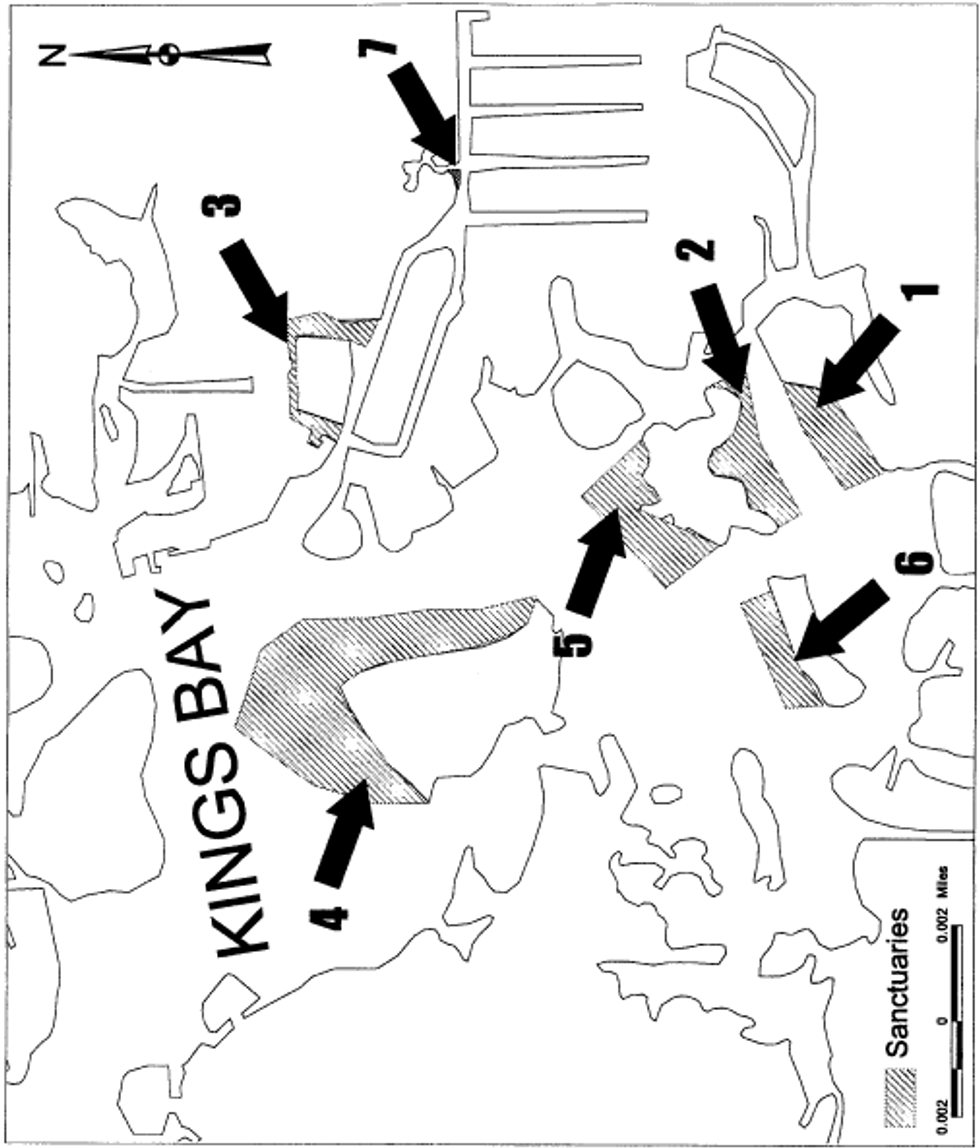
(8) That part of the Homosassa River, Homosassa, Citrus County, Florida, within Section 28, Township 19 South, Range 17 East, described as the headwaters of the Homosassa River (adjacent to the Homosassa Springs State Wildlife Park), including the spring run at the point where the run enters the northeast fork of the river along the southeastern shore and an area opposite this site along the southern shoreline; containing approximately 0.67 ha (1.66 acres). Map follows (see Blue Waters Manatee Sanctuary):
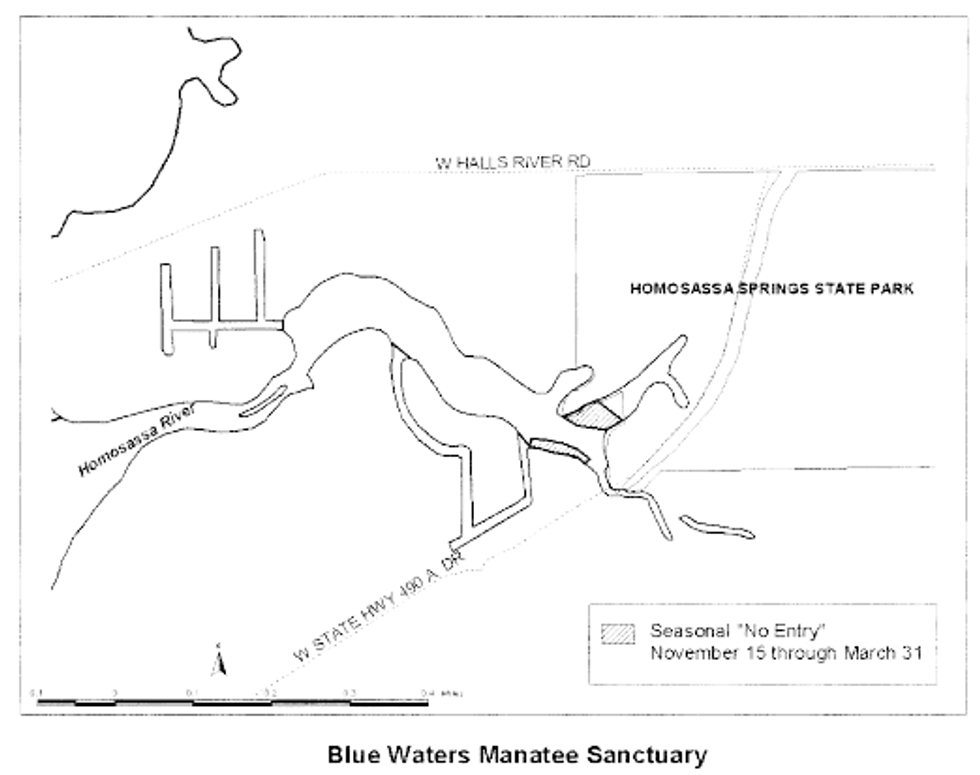
(9) That part of Tampa Bay, St. Petersburg, Pinellas County, Florida, within Sections 16 and 21, Township 30 South, Range 17 East, described as the warm-water outflow of the Bartow Electric Generating Plant located on the northern shore of Weedon Island, encircling that point where the discharge enters receiving waters along the western shore of Old Tampa Bay; to be known as the Bartow Electric Generating Plant Manatee Sanctuary, containing approximately 12.07 ha (29.82 acres). Map follows (see Bartow Electric Generating Plant Manatee Sanctuary):
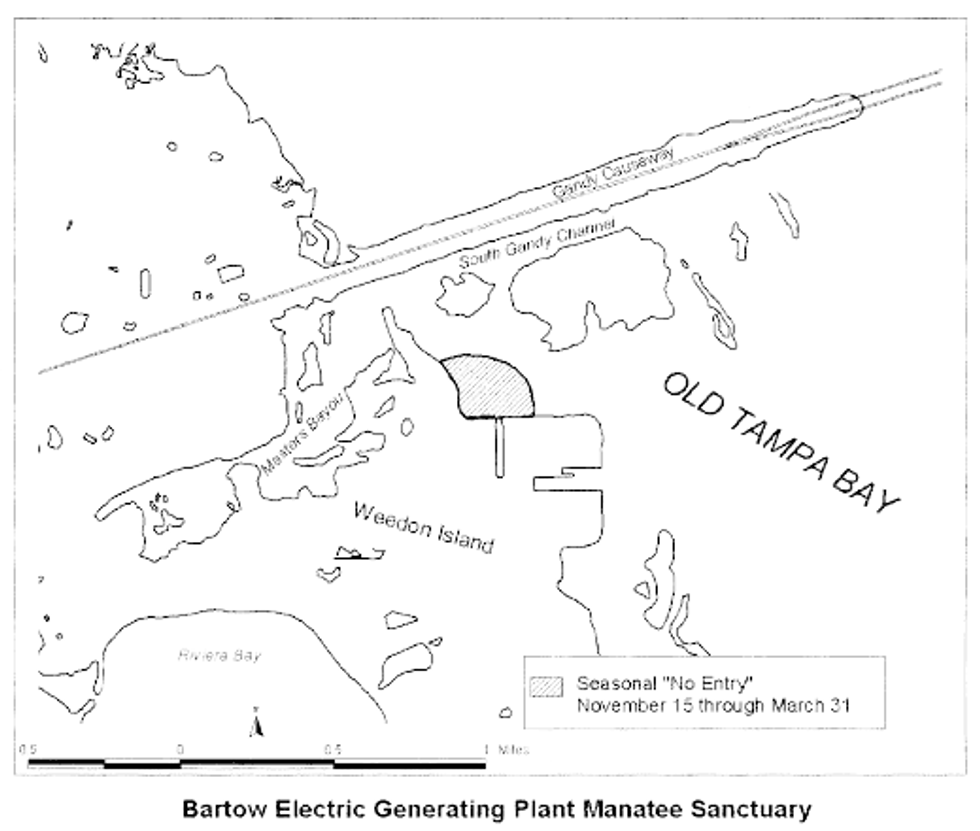
(10) That part of Tampa Bay, Tampa, Hillsborough County, Florida, within Sections 10 and 15, Township 31 South, Range 19 East, described as the waters in and around the warm-water outflow of the Tampa Electric Company Big Bend Electric Generating Station located west of Jackson Branch and including the Big Bend area of eastern Tampa Bay, to be known as the Tampa Electric Company Big Bend Manatee Sanctuary, containing approximately 12.08 ha (29.85 acres). Map follows (See TECO Big Bend Manatee Sanctuary):
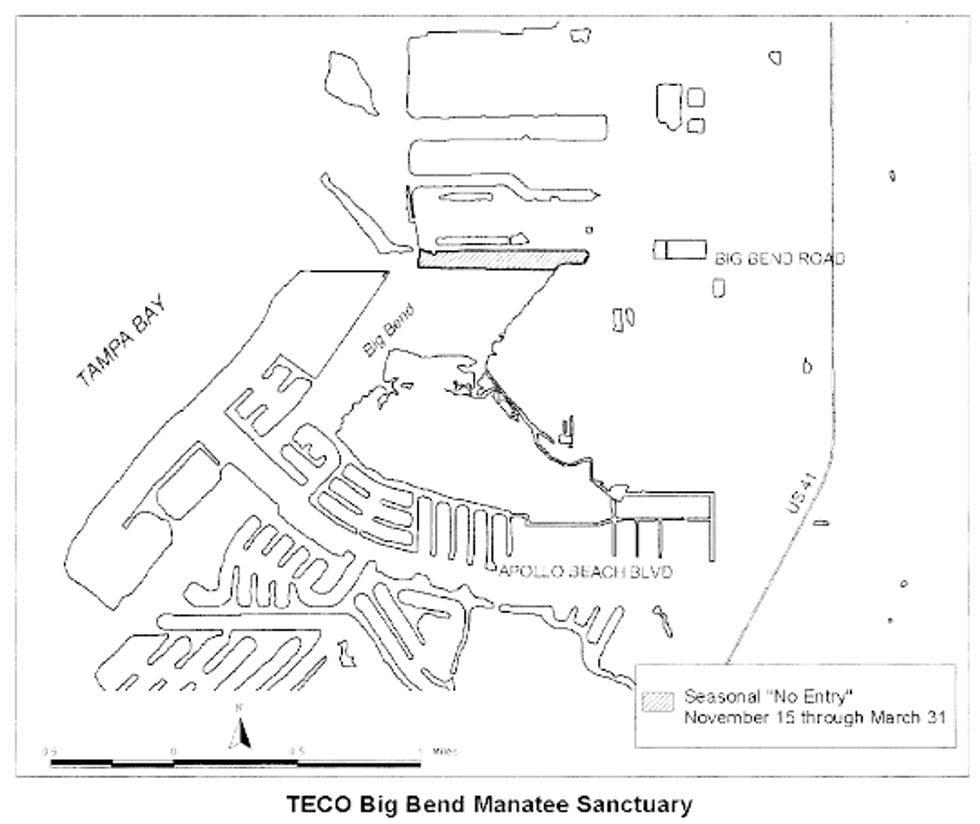
(11) That part of Tampa Bay, Tampa, Hillsborough County, Florida, lying within Section 4, Township 30 South, Range 19 East, described as the warm-water outflow of the Tampa Electric Company Gannon Electric Generating Station, to be known as the Port Sutton Manatee Sanctuary, containing approximately 1.1 ha (2.7 acres). Map follows (see Port Sutton Manatee Sanctuary):
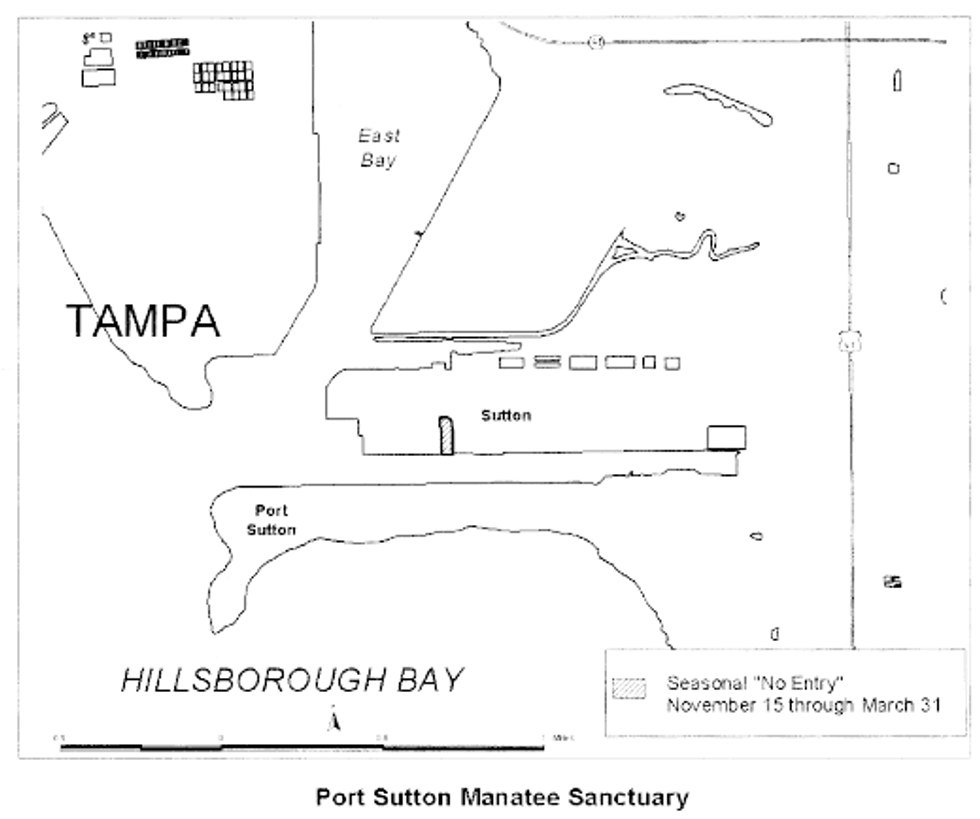
(b) Exceptions. (1) Adjoining property owners, their guests, employees, and their designees (including but not limited to contractors and lessees) may engage in watercraft access and property maintenance activities through manatee sanctuaries (set forth in paragraphs (a)(1) through (a)(11) of this section) and designated �no-entry areas� in the Kings Bay Manatee Refuge (set forth in paragraph (c)(14) of this section). Use of sanctuary and no-entry area waters is restricted to authorized individuals accessing adjoining properties, storing watercraft, and maintaining property and waterways. Maintenance activities include those actions necessary to maintain property and waterways, subject to any Federal, State, and local government permitting requirements.
(2) Authorized individuals must obtain a sticker or letter of authorization from the U.S. Fish and Wildlife Service identifying them as individuals authorized to enter no-entry areas that adjoin their property. Stickers must be placed in a conspicuous location to readily identify authorized watercraft. Individuals with a letter of authorization must have a valid letter in their possession when accessing no-entry areas.
(3) Authorized individuals must conduct any authorized boating activity within these areas at idle or no-wake speeds.
(c) Manatee refuges. The following areas are designated as manatee refuges. For each manatee refuge, we will state on appropriate signs which, if any, waterborne activities are prohibited, and state the applicable restrictions, if any, on permitted waterborne activities. The areas that will be posted are described as follows:
(1) The Barge Canal Manatee Refuge. (i) The Barge Canal Manatee Refuge is described as all waters lying within the banks of the Barge Canal, Brevard County, Florida, including all waters lying within the marked channel in the Banana River that lie between the east entrance of the Barge Canal and the Canaveral Locks; containing approximately 276.3 ha (682.7 acres).
(ii) Watercraft are required to proceed at slow speed (channel included) all year. The use of watercraft at speeds greater than slow speed is prohibited throughout the Barge Canal Manatee Refuge.
(iii) Map of the Barge Canal Manatee Refuge follows:
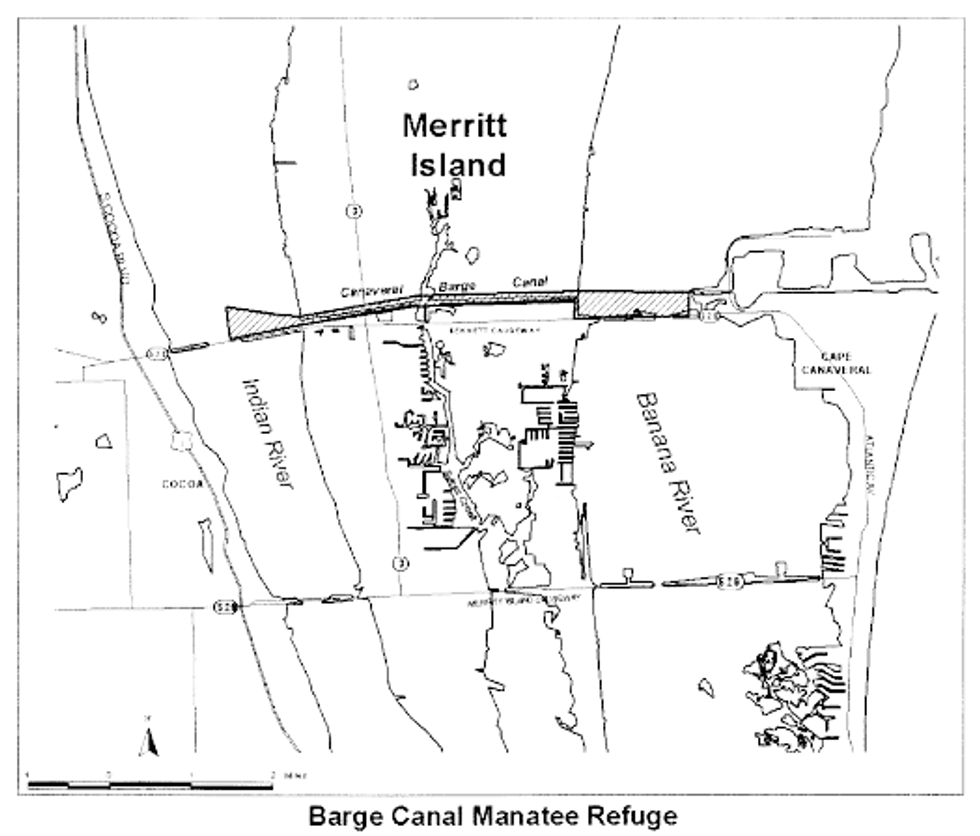
(2) The Sykes Creek Manatee Refuge. (i) The Sykes Creek Manatee Refuge is described as all waters, including the marked channel in Sykes Creek, Brevard County, Florida. In particular, the portion of Sykes Creek southerly of the southern boundary of that portion of the creek commonly known as the �S� curve (said boundary being a line bearing east from a point on the western shoreline of Sykes Creek at approximate latitude 28 degrees 23?24? N, approximate longitude 80 degrees 41?27? W) and northerly of the Sykes Creek Parkway; containing approximately 342.3 ha (845.8 acres).
(ii) Watercraft are required to proceed at slow speed (channel included) all year. The use of watercraft at speeds greater than slow speed is prohibited throughout the Sykes Creek Manatee Refuge.
(iii) Map of the Sykes Creek Manatee Refuge follows:
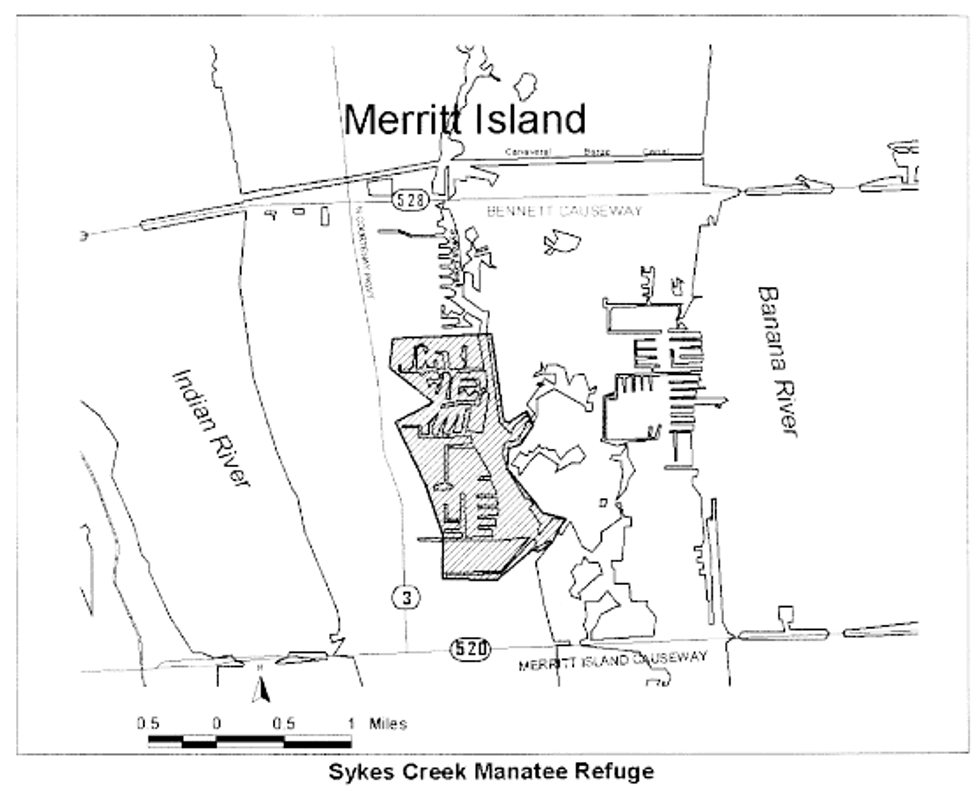
(3) The Tampa Electric Company's Big Bend Manatee Refuge. (i) The Tampa Electric Company's Big Bend Manatee Refuge is described as the entrance channel and those waters south of the manatee sanctuary at the Tampa Electric Company's Big Bend Electric Generating Station within Hillsborough County, Florida; containing approximately 89.35 ha (220.79 acres).
(ii) Watercraft are required to operate at idle speed from November 15 through March 31. Watercraft are prohibited from operating at speeds greater than idle speed from November 15 through March 31, inclusive.
(iii) Map of the Tampa Electric Company's Big Bend Manatee Refuge follows (see TECO Big Bend Manatee Refuge):
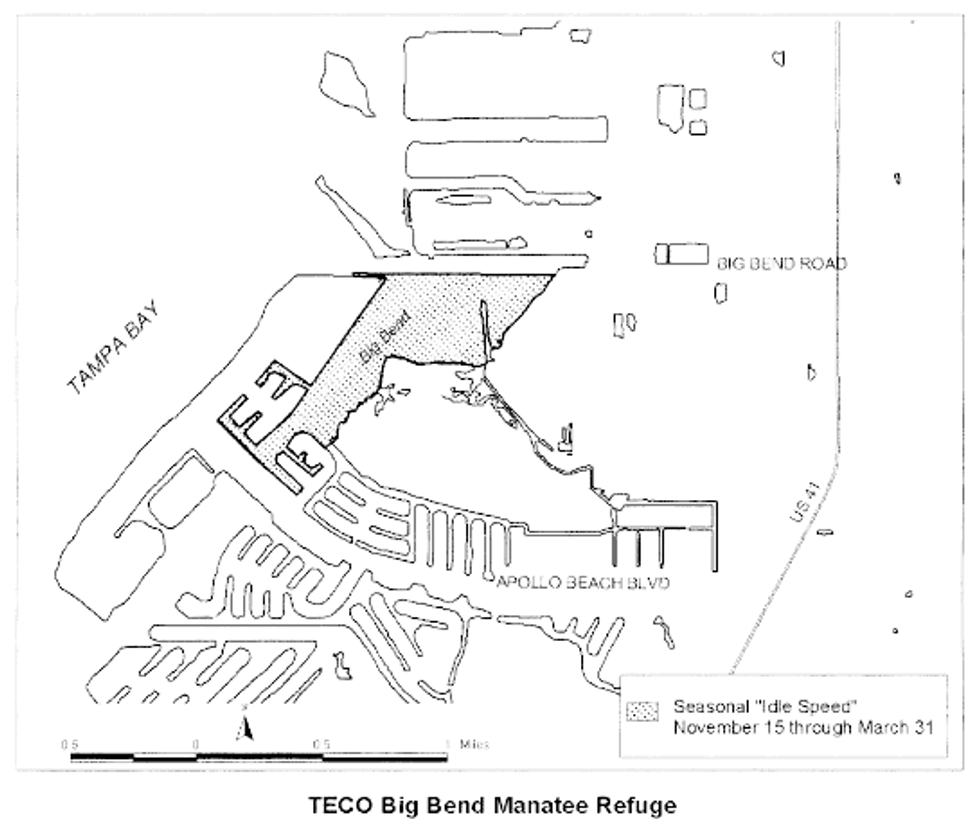
(4) The Port Sutton Manatee Refuge. (i) The Port Sutton Manatee Refuge is described as those waters surrounding the Port Sutton Manatee Sanctuary, including all waters within Port Sutton, Hillsborough County, Florida; containing approximately 39.2 ha (96.9 acres).
(ii) Watercraft are required to operate at idle speed from November 15 through March 31, inclusive. Watercraft are prohibited from operating at speeds greater than idle speed from November 15 through March 31, inclusive.
(iii) Map of Port Sutton Manatee Refuge follows (see Port Sutton Manatee Refuge):
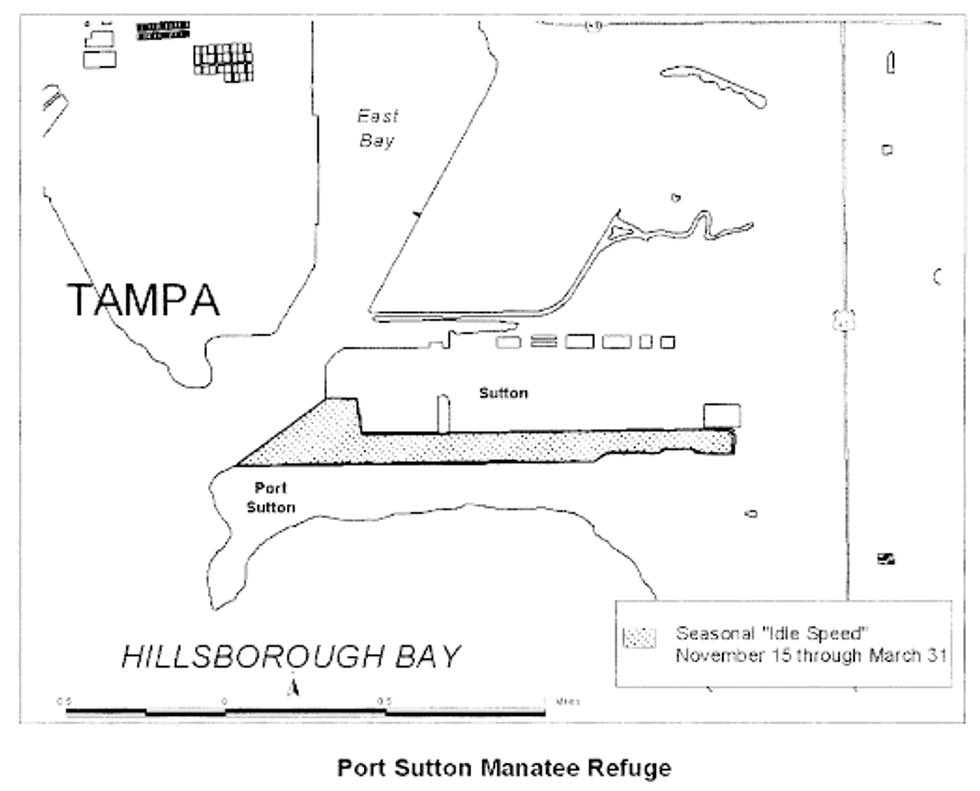
(iv) Map showing the relative locations of the Bartow, TECO Big Bend, and Port Sutton areas of Tampa Bay follows (see Tampa Bay Manatee Sanctuaries and Refuges):
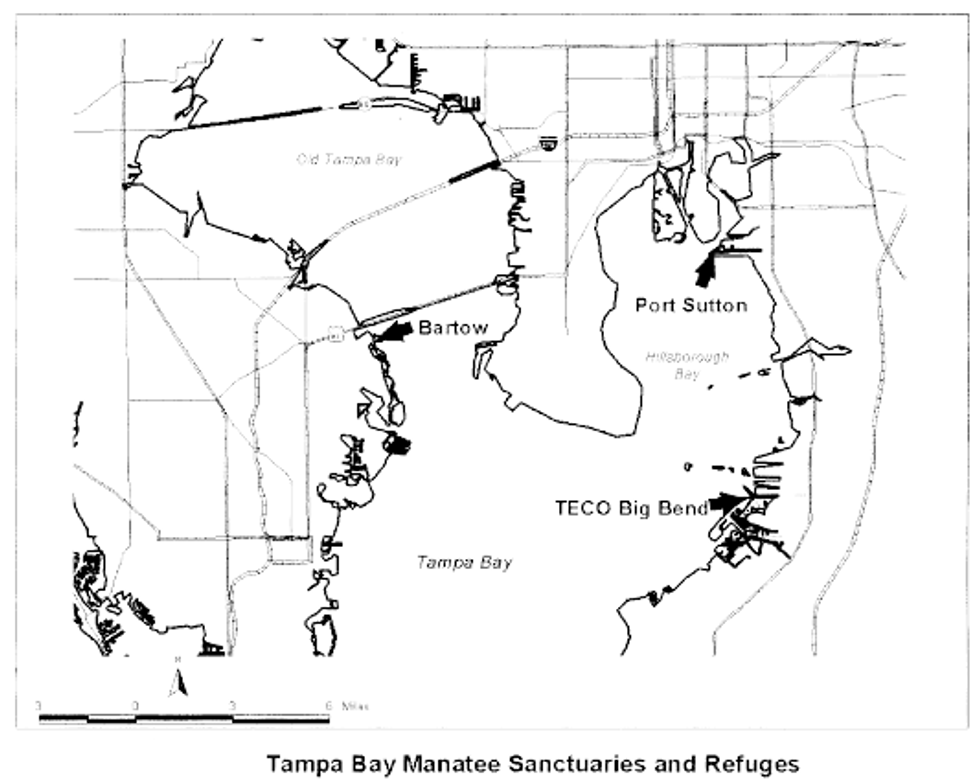
(5) The Little Sarasota Bay Manatee Refuge. (i) The Little Sarasota Bay Manatee Refuge is described as those waters lying southerly of a line that bears north 90 degrees 00?00? E (true) and runs through the southerly tip of the first unnamed island south of Red Intracoastal Waterway Channel Marker �40� (latitude 27 degrees 10?07? N, longitude 82 degrees 30?05? W) and those waters lying northerly of the Blackburn Point Bridge, Sarasota County, Florida; containing approximately 214.2 ha (529.40 acres).
(ii) Watercraft are required to proceed at slow speed, 40 kilometers per hour (25 miles per hour) within the channel, year-round. Watercraft are prohibited from operating in excess of slow speed outside of the channel and operating at speeds in excess of 40 kilometers per hour (25 miles per hour) within the channel, year-round.
(iii) Map of the Little Sarasota Bay Manatee Refuge follows (see Little Sarasota Bay Manatee Refuge):
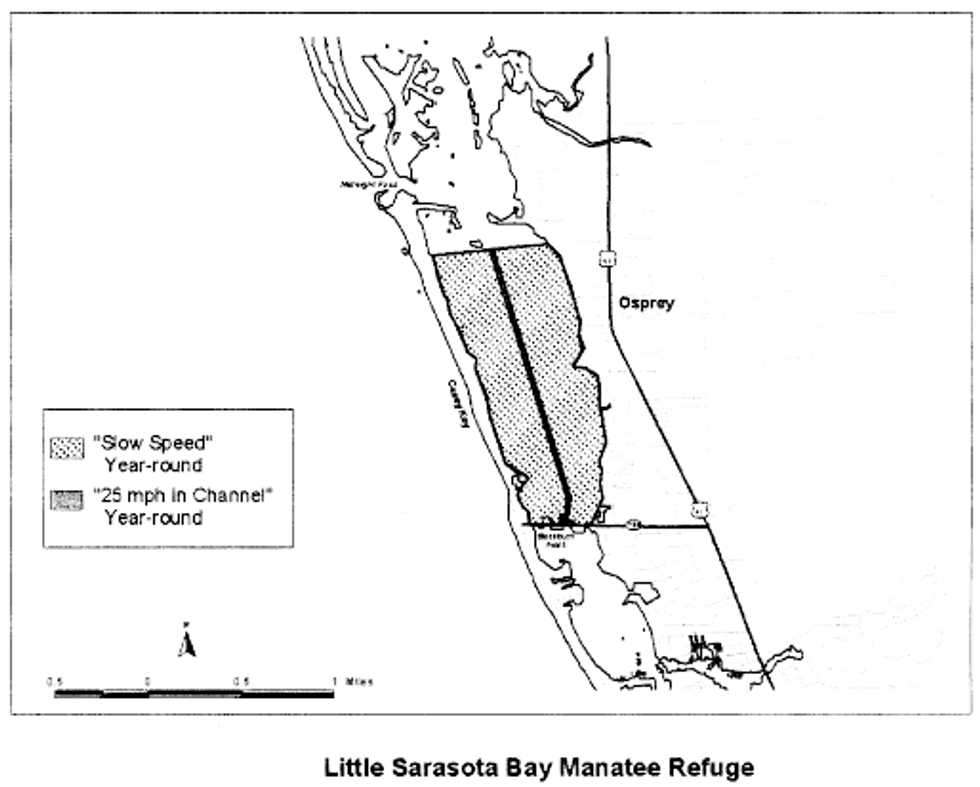
(6) The Lemon Bay Manatee Refuge. (i) The Lemon Bay Manatee Refuge is described as those waters of Lemon Bay lying south of the Sarasota/Charlotte County, Florida, boundary and north of a line north 60 degrees 14?00? E (true) parallel with a series of small islands approximately 1.6 kilometer (1 mile) south of the Bay Road Bridge; containing approximately 383.61 ha (948.06 acres).
(ii) Watercraft are required to proceed at slow speed, 40 kilometers per hour (25 miles per hour) within the channel, year-round. Watercraft are prohibited from operating in excess of slow speed outside of the channel and operating at speeds in excess of 40 kilometers per hour (25 miles per hour) within the channel, year-round.
(iii) Map of the Lemon Bay Manatee Refuge follows (see Lemon Bay Manatee Refuge):

(7) The Peace River Manatee Refuge. (i) The Peace River Manatee Refuge is described as all waters of the Peace River and certain associated water bodies north and east of the U.S. Highway 41, Charlotte and De Soto Counties, Florida; containing approximately 1.698.11 ha (4,196.11 acres).
(ii) In the Peace River in Charlotte County, watercraft are required to travel at slow speed within a posted shoreline buffer between the US Highway 41 and I-75 bridges. The buffer is approximately 300 meters (1,000 feet) from shore except in a slightly larger area north and west of I-75 to be consistent with recently adopted Florida Fish and Wildlife Conservation Commission's regulations. Watercraft are allowed to travel at a maximum speed of 40 kilometers per hour (25 miles per hour) year-round outside the buffer. Watercraft are prohibited from traveling in excess of slow speed within the posted shoreline buffer between the U.S. Highway 41 and I-75 bridges and are further prohibited from operating in excess of 40 kilometers per hour (25 miles per hour) outside the buffer throughout the year.
(iii) In the Peace River within Charlotte County and upstream of I-75 to red channel marker �14,� watercraft are required to travel at slow speed outside of the marked navigation channel. Watercraft are allowed to travel at a maximum speed of 40 kilometers per hour (25 miles per hour) year-round inside the marked navigation channel. Watercraft are prohibited from traveling in excess of slow speed in areas outside of the navigation channel and are further prohibited from traveling in excess of 40 kilometers per hour (25 miles per hour) inside the marked navigation channel, year-round.
(iv) In the waters of the Peace River in Charlotte and De Soto Counties upstream of red channel marker �14,� watercraft are allowed to travel at a maximum speed of 40 kilometers per hour (25 miles per hour) year-round. Watercraft are prohibited from traveling in excess of 40 kilometers per hour (25 miles per hour), year-round, in this area.
(v) Within the waters of Jim Long Lake and Hunter Creek in Charlotte and De Soto Counties, watercraft are required to travel at slow speed year-round. Watercraft are prohibited from traveling in excess of slow speed in this area, year-round.
(vi) Within the waters of Deep Creek in Charlotte and De Soto Counties, watercraft are required to travel at slow speed year-round. Watercraft are prohibited from traveling in excess of slow speed in this area, year-round.
(vii) Within the waters of Shell Creek in Charlotte County, watercraft are required to travel at slow speed year-round with the following exception. Should a U.S. Coast Guard or State of Florida approved marked navigation channel be established in that portion of Shell Creek approximately 1.6 kilometers (1 mile) downstream of the Seaboard Railroad trestles, watercraft will be allowed to travel at a maximum speed of 40 kilometers per hour (25 miles per hour) in this section of Shell Creek upon posting by the Fish and Wildlife Service or the Florida Fish and Wildlife Conservation Commission. Watercraft are prohibited from traveling in excess of slow speed in this area, year-round.
(viii) Map of the Peace River Manatee Refuge follows (see Peace River Manatee Refuge):

(8) The Shell Island Manatee Refuge. (i) The Shell Island Manatee Refuge is described as all waters within the marked Intracoastal Waterway channel between Green Marker �99� (approximate latitude 26 degrees 31?00? N, approximate longitude 82 degrees 00?52? W) and Green Marker �93� (approximate latitude 26 degrees 31?37? N, approximate longitude 81 degrees 59?46? W), Lee County, Florida; containing approximately 32.6 ha (80.5 acres).
(ii) Watercraft are required to proceed at slow speed (channel included) year-round. Watercraft are prohibited from traveling in excess of slow speed in this area, year-round.
(iii) Map of the Shell Island Manatee Refuge follows (see Shell Island Manatee Refuge):
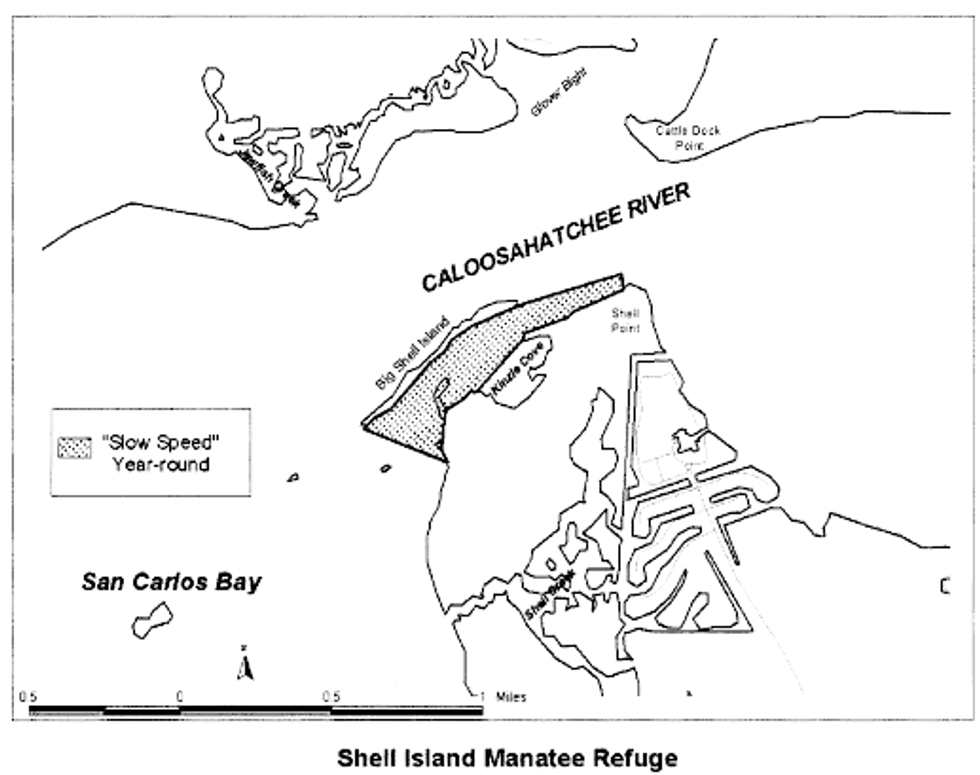
(9) The Haulover Canal Manatee Refuge. (i) The Haulover Canal Manatee Refuge is described as all waters lying within Haulover Canal in Brevard County, Florida; containing approximately 8.95 ha (22.11 acres).
(ii) Watercraft are required to proceed at slow speed (channel included) year-round. Watercraft are prohibited from traveling in excess of slow speed in this area, year-round.
(iii) Map of the Haulover Canal Manatee Refuge follows (see Haulover Canal Manatee Refuge):
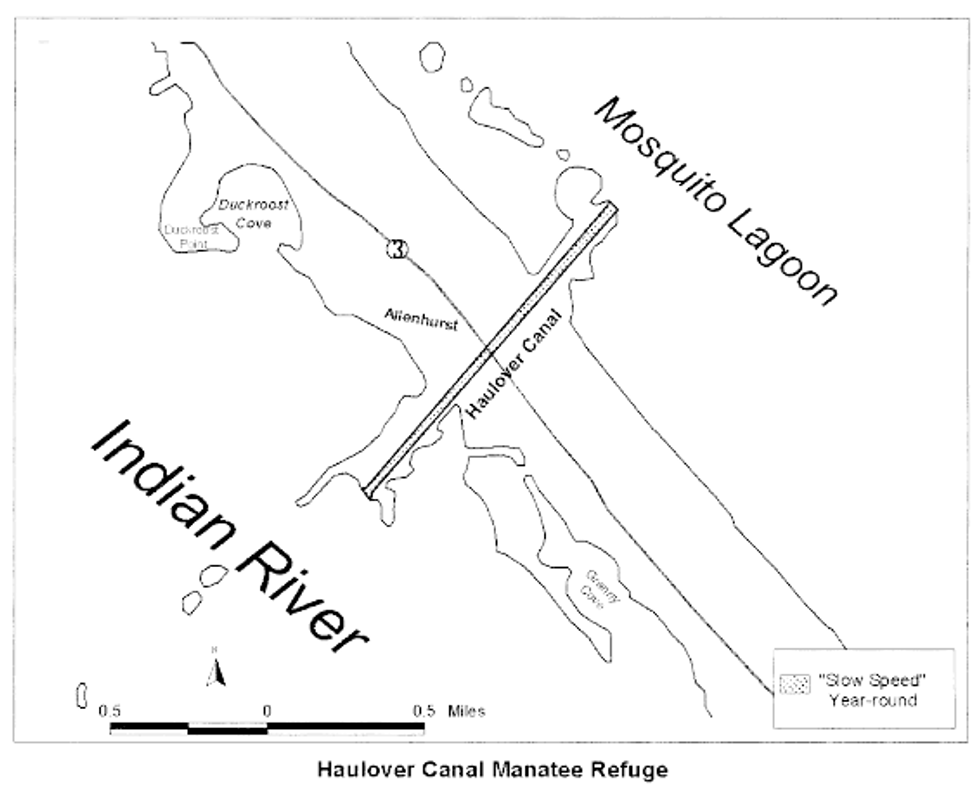
(10) The Caloosahatchee River - San Carlos Bay Manatee Refuge. (i) The Caloosahatchee River - San Carlos Bay Manatee Refuge is described as all waters of the Caloosahatchee River and San Carlos Bay downstream of the Seaboard Coastline trestle at Beautiful Island to Channel Marker �93� and from Channel Marker �99� to the Sanibel Causeway, in Lee County. A map showing the refuge and four maps showing specific areas in the refuge are at paragraph (10)(x) of this section.
(ii) From the Seaboard Coastline Railroad trestle at Beautiful Island, downstream to Channel Marker �25�, a distance of approximately 1.6 kilometers (1 mile), watercraft are required to proceed at slow speed in the marked navigation channel from November 15 to March 31 and at not more than 40 kilometers per hour (km/h) (25 miles per hour) in the channel from April 1 to November 14. See map of �Edison Bridge Area� in paragraph (10)(x) of this section.
(iii) From a point 152 meters (500 feet) east of the Edison Bridge downstream to a point 152 meters (500 feet) west of the Caloosahatchee Bridge, approximately 1.1 kilometers (0.7 mile) in length, shoreline-to-shoreline (including the marked navigation channel), watercraft are required to proceed at slow speed (channel included), year-round. See map of �Edison Bridge Area� in paragraph (10)(x) of this section.
(iv) From a point 152 meters (500 feet) west of the Caloosahatchee Bridge downstream to a point 152 meters (500 feet) northeast of the Cape Coral Bridge, a distance of approximately 10.9 kilometers (6.8 miles), watercraft are required to proceed year-round at slow speed, while traveling within shoreline buffers extending out from the shore to a minimum distance of approximately 402 meters (1,320 feet), as marked. Watercraft, with the exception of seaplanes, are required to proceed at not more than 40 km/h (25 miles per hour) throughout the year between these buffers (including the marked navigation channel where not more restrictively designated). See map of �Cape Coral Bridge Area� in paragraph (10)(x) of this section.
(v) From a point 152 meters (500 feet) northeast of the Cape Coral Bridge downstream to a point 152 meters (500 feet) southwest of the Cape Coral Bridge, a distance of approximately 0.4 kilometer (0.25 mile), shoreline-to-shoreline (excluding the marked navigation channel), watercraft are required to proceed at slow speed, year-round. In the marked navigation channel, watercraft are required to proceed at not more than 40 km/h (25 miles per hour) throughout the year. See map of �Cape Coral Bridge Area� in paragraph (10)(x) of this section.
(vi) From a point 152 meters (500 feet) southwest of the Cape Coral Bridge to Channel Marker �72,� a distance of approximately 1.9 kilometers (1.2 miles), watercraft are required to proceed year-round at slow speed, while traveling within shoreline buffers extending out from the shore to a minimum distance of approximately 402 meters (1,320 feet), as marked. Watercraft are required to proceed at not more than 40 km/h (25 miles per hour) throughout the year between these buffers (including the marked navigation channel where not more restrictively designated). See map of �Redfish Point Area� in paragraph (10)(x) of this section.
(vii) From Channel Marker �72� to Channel Marker �76� (in the vicinity of Redfish Point), for a distance of approximately 1.8 kilometers (1.1 miles) in length, shoreline-to-shoreline (including the marked navigation channel), watercraft are required to proceed at slow speed, year-round. See map of �Redfish Point Area� in paragraph (10)(x) of this section.
(viii) From Channel Marker �76� to Channel Marker �93,� a distance of approximately 5.2 kilometers (3.2 miles) in length, watercraft are required to proceed year-round at slow speed, while traveling within shoreline buffers extending out from the shore to a minimum distance of approximately 402 meters (1,320 feet), as marked. Watercraft are required to proceed at not more than 40 km/h (25 miles per hour) throughout the year between these buffers (including the marked navigation channel where not more restrictively designated). See map of �Redfish Point Area� in paragraph (10)(x) of this section.
(ix) Except as described below and as marked, from Channel Marker �99� to the Sanibel Causeway, watercraft are required to proceed at slow speed year-round in San Carlos Bay within the following limits: A northern boundary described by the southern edge of the marked navigation channel, a line approximately 2.9 kilometers (1.8 miles) in length; a southern boundary described by the Sanibel Causeway (approximately 1.9 kilometers (1.2 miles) in length); a western boundary described by a line that connects the western end of the easternmost Sanibel Causeway island and extending northwest to Channel Marker �7� (approximately 2.9 kilometers (1.8 miles) in length); and the eastern boundary includes the western limit of the State-designated manatee protection area (68C-22.005) near Punta Rassa (approximately 2.9 kilometers (1.8 miles) in length). However this area excludes the marked navigation channel from Channel Marker �99� to the Sanibel Causeway and adjacent waters, as marked. See map of �San Carlos Bay� in paragraph (10)(x) of this section.
(x) Five maps of the Caloosahatchee River - San Carlos Bay Manatee Refuge follow:

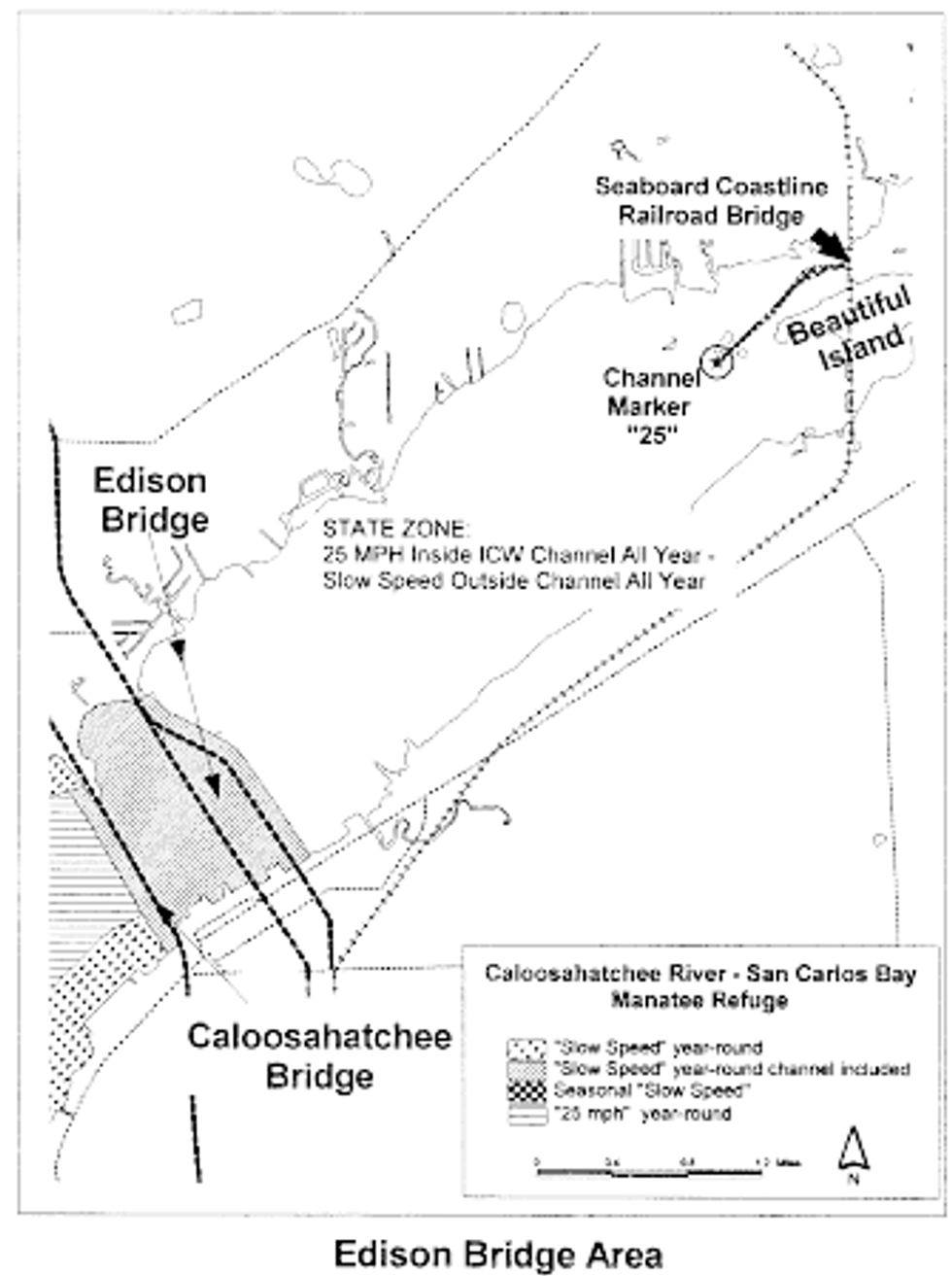
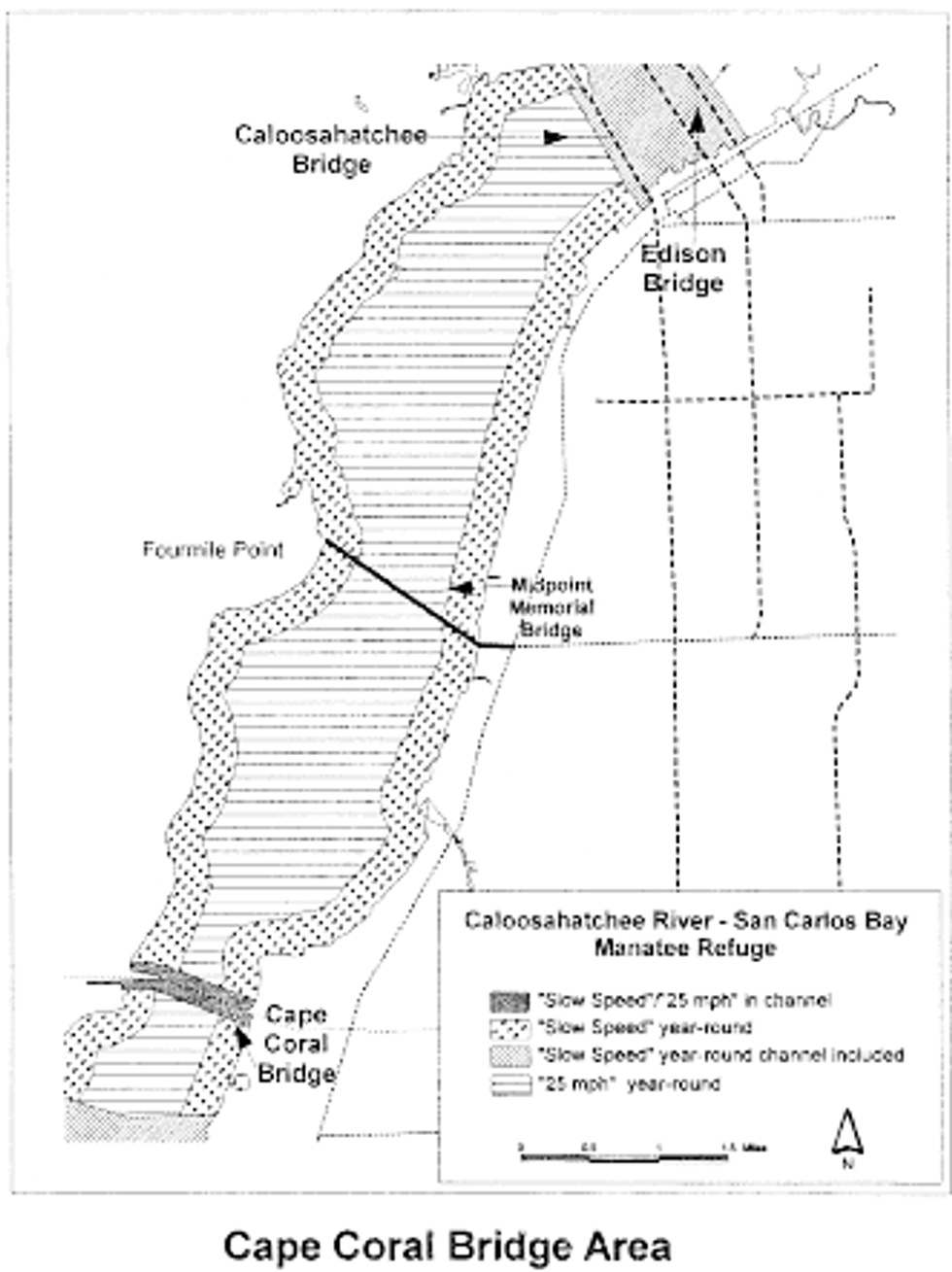
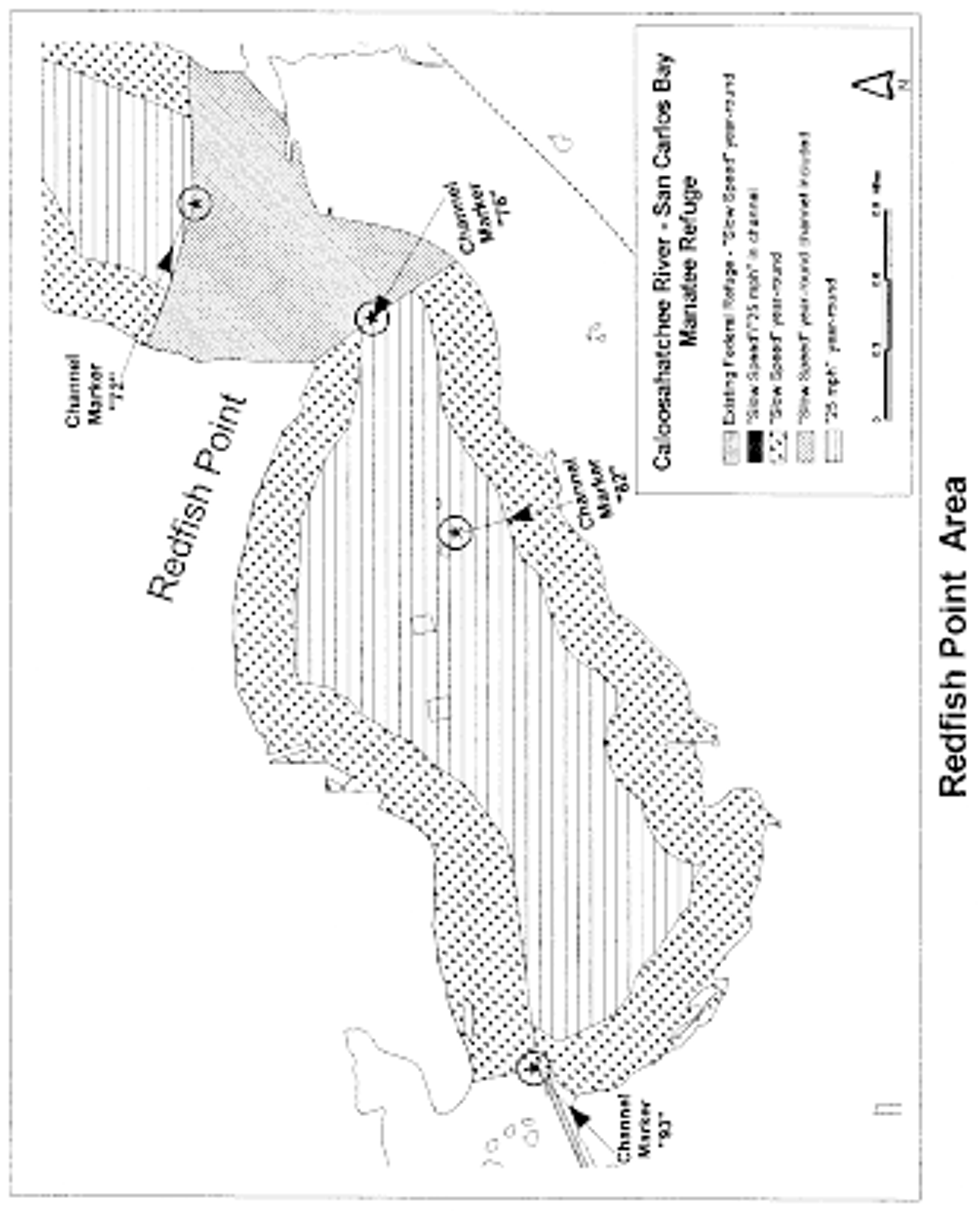
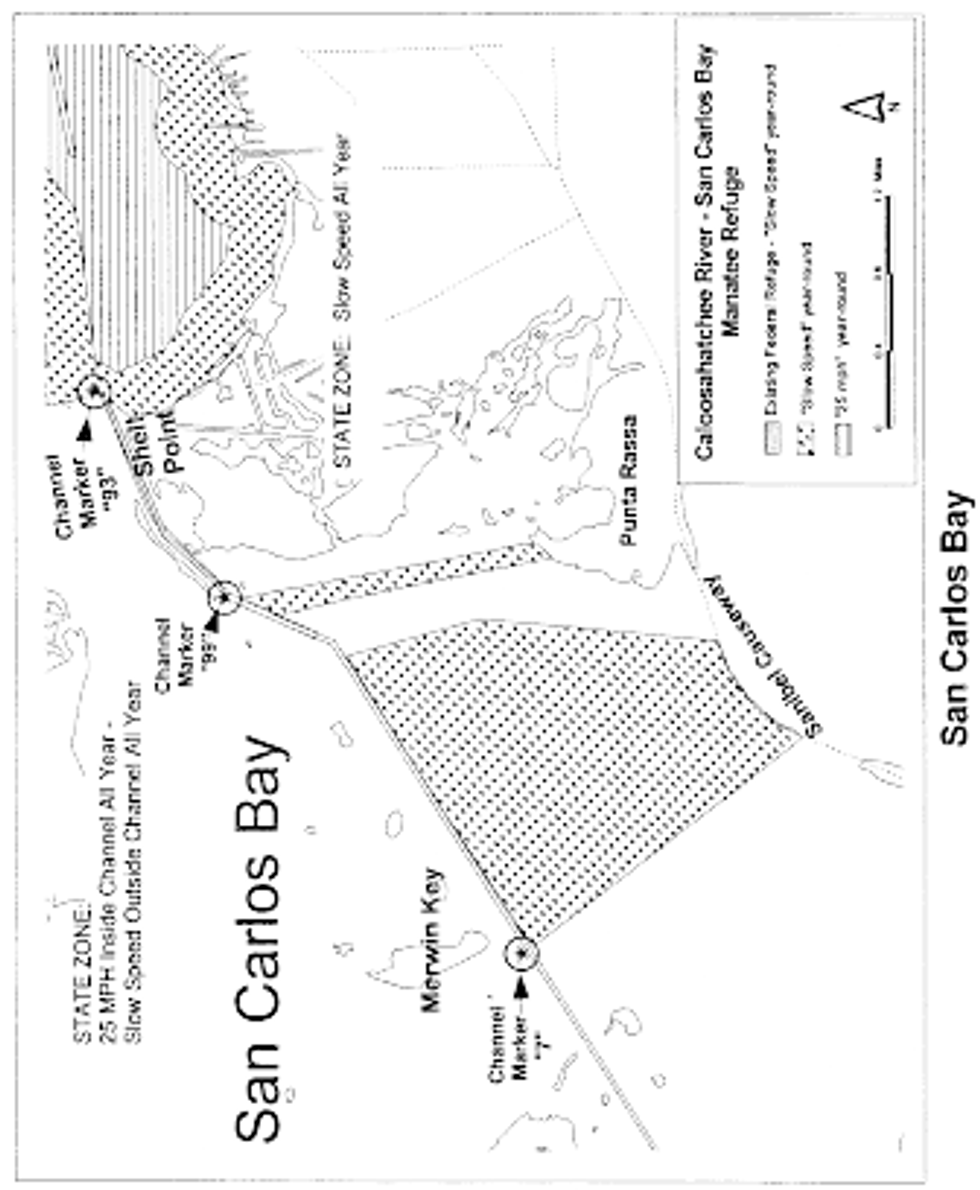
(11) The Lower St. Johns River Manatee Refuge. (i) The Lower St. Johns River Manatee Refuge is described as portions of the St. Johns River and adjacent waters in Duval, Clay, and St. Johns Counties from Sandfly Point (the intersection of the right descending bank of the Trout River and the left descending bank of the St. Johns River) and Reddie Point, as marked, upstream to the mouth of Peter's Branch, including Doctors Lake, in Clay County on the western shore, and to the southern shore of the mouth of Julington Creek in St. Johns County on the eastern shore. A map showing the refuge and two maps showing specific areas of the refuge are at paragraph (11)(vi) of this section.
(ii) In the St. Johns River from Sandfly Point on the left descending bank of the St. Johns River and Reddie Point on the right descending bank of the St. Johns River, upstream to the Hart Bridge, a distance of approximately 5.5 miles (8.8 km), watercraft are required to proceed at slow speed, year-round, within 300 feet (91 m) of the shoreline on the left descending bank of the St. Johns River and within a buffer as marked, typically about 1,000 feet (305 m) from the shoreline along the right descending bank of the river. The slow speed designation also includes that portion of the river between Exchange Island and the right descending bank, a marked buffer approximately 300 feet (91 m) along the west (channel-ward) shoreline of Exchange Island, and a portion of the Arlington River as marked. Watercraft are also required to proceed at not more than 25 miles per hour (40 km/h), year round, in the area posted as such between these slow speed shoreline buffers. See map of �St. Johns River Bridges Area� in paragraph (11)(vi) of this section.
(iii) From the Hart Bridge to the Main Street Bridge, a distance of approximately 2 miles (3.2 km), watercraft are required to proceed at slow speed, year-round, outside the marked navigation channel and at speeds of not more than 25 miles per hour (40 km/h) in the marked channel (from Channel Marker �81� to the Main Street Bridge, the channel is defined as the line of sight extending west from Channel Markers �81� and �82� to the fenders of the Main Street Bridge). See map of �St. Johns River Bridges Area� in paragraph (11)(vi) of this section.
(iv) From the Main Street Bridge to the Fuller Warren Bridge, a distance of approximately 1 mile (1.6 km), shoreline to shoreline, watercraft are required to proceed at slow speed (channel included), year-round. See map of �St. Johns River Bridges Area� in paragraph (11)(vi) of this section.
(v) Upstream of the Fuller Warren Bridge: for a distance of approximately 19.3 miles (31.1 km) along the left descending bank of the St. Johns River, watercraft are required to proceed at slow speed, year-round, in a 700-foot (213 m) to 1,000-foot (305 m) as-marked, shoreline buffer from the Fuller Warren Bridge to the south bank of the mouth of Peter's Branch in Clay County; for a distance of approximately 20.2 miles (32.5 km) along the right descending bank of the St. Johns River, watercraft are required to proceed at slow speed, year round, in a 700-foot (213 m) to 1,000-foot (305 m) as marked, shoreline buffer from the Fuller Warren Bridge to the south bank of the mouth of Julington Creek in St. Johns County (defined as a line north of a western extension of the Nature's Hammock Road North); and in Doctors Lake in Clay County watercraft are required to proceed at slow speed, year-round, in a 700-foot (213 m) to 900-foot (274 m) as-marked, shoreline buffer (approximately 12.9 miles (20.8 km)). See map of �Lower St. Johns River� in paragraph (11)(vi) of this section.
(vi) Three maps of the Lower St. Johns River Manatee Refuge follow:


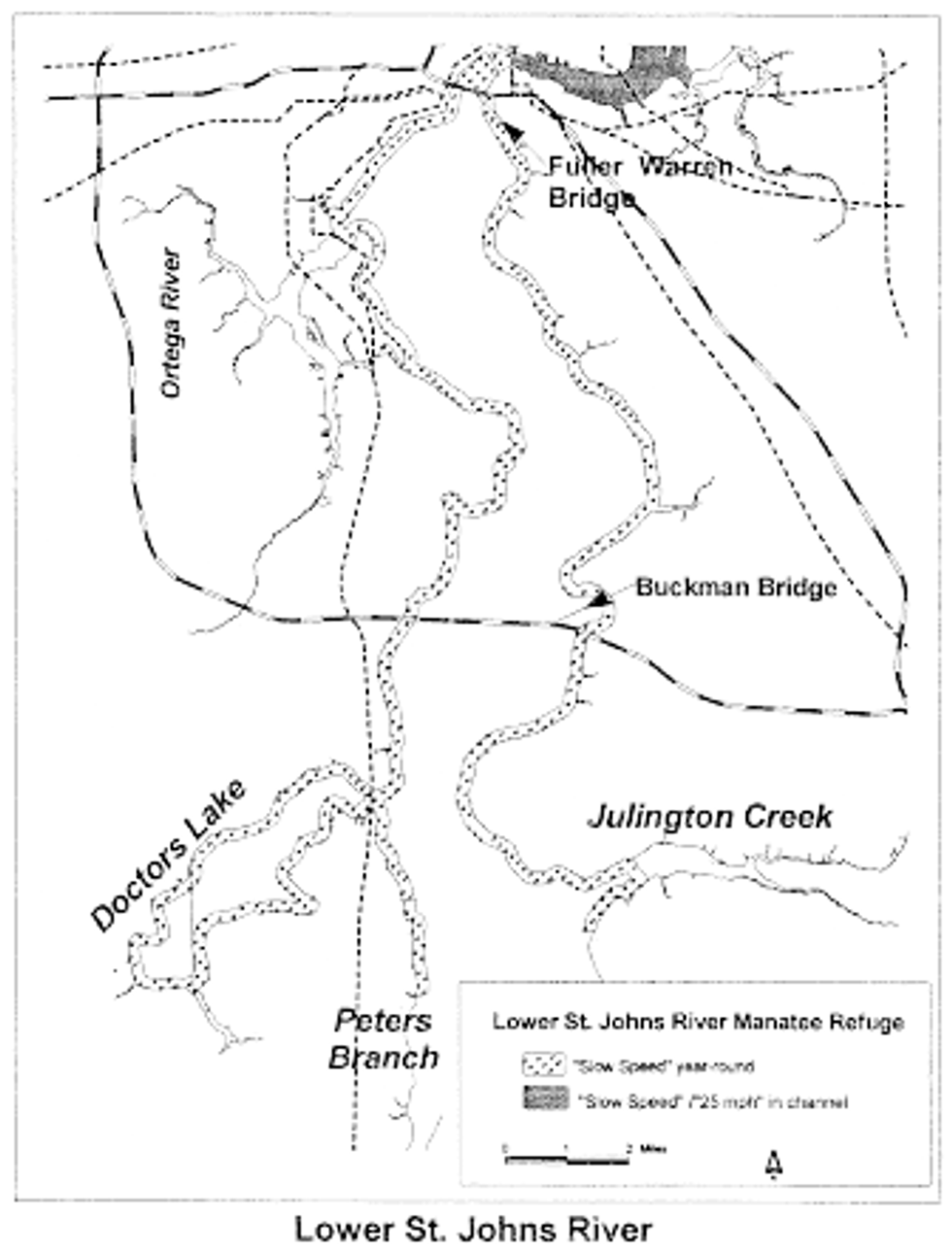
(12) The Halifax and Tomoka Rivers Manatee Refuge. (i) The Halifax and Tomoka Rivers Manatee Refuge is described as the Halifax River and associated waterbodies in Volusia County, from the Volusia County - Flagler County line to New Smyrna Beach. A map showing the refuge and eight maps showing specific areas in the refuge are at paragraph (12)(xii) of this section.
(ii) From the Volusia County - Flagler County line at Halifax Creek south to Channel Marker �9,� a distance of approximately 11.3 kilometers (7.0 miles) in length, watercraft are required to proceed at not more than 40 km/h (km/h)(25 miles per hour) in the channel. See maps of �Halifax Creek� and �Tomoka River Basin� in paragraph (12)(xii) of this section.
(iii) From Channel Marker �9� to a point 152 meters (500 feet) north of the Granada Bridge (State Road 40) (including the Tomoka Basin), a distance of approximately 5.0 km (3.1 miles) in length, watercraft are required to proceed at not more than 40 km/h (25 mph) in areas between the existing 91-meter (300-foot) buffers (and including the marked navigation channel). See maps of �Tomoka River Basin� and �Tomoka River� in paragraph (12)(xii) of this section.
(iv) In the Tomoka River, from the I-95 Bridge to Alligator Island, as marked, a distance of approximately 1.6 kilometers (1 mile), watercraft are required to proceed at slow speed, shoreline to shoreline, from April 1 to August 31. See map of �Tomoka River� in paragraph (12)(xii) of this section.
(v) From 152 meters (500 feet) north to 305 meters (1,000 feet) south of the Granada Bridge (State Road 40), a distance of approximately 0.5 kilometers (0.3 miles) in length, watercraft are required to proceed at slow speed, year-round, shoreline to shoreline. See map of �Halifax River A� in paragraph (12)(xii) of this section.
(vi) From a point 305 meters (1,000 feet) south of the Granada Bridge (State Road 40) to a point 152 meters (500 feet) north of the Seabreeze Bridge, a distance of approximately 6.4 km (4.0 miles) in length, watercraft are required to proceed at not more than 40 km/h (25 mph) in areas between the existing 91-meter (300-foot) buffers (and including the marked navigation channel). See map of �Halifax River A� in paragraph (12)(xii) of this section.
(vii) As marked, from 152 meters (500 feet) north of the Seabreeze Bridge, to 152 meters (500 feet) north of the Main Street bridge, a distance of approximately 1 kilometer (1 mile) in length, watercraft are required to proceed at slow speed (channel included), year-round. See map of �Halifax River B� in paragraph (12)(xii) of this section.
(viii) From Channel Marker �40� to a point a minimum of 152 meters (500 feet) north, as marked, of the Dunlawton Bridge, a distance of approximately 14.5 kilometers (9 miles) in length, watercraft are required to proceed at not more than 40 km/h (25 mph) in areas between the existing 91-meter (300-foot) buffers (and including the marked navigation channel). See map of �Halifax River B� in paragraph (12)(xii) of this section.
(ix) As marked, a minimum of 152 meters (500 feet) north to 152 meters (500 feet) south of the Dunlawton Bridge, a distance of approximately 0.3 kilometers (0.2 miles) in length, watercraft are required to proceed at slow speed (channel included), year-round, shoreline to shoreline; and adjacent to the western shoreline of the Halifax River north of the Dunlawton Bridge for a distance of approximately 640 meters (2,100 feet), and a minimum of 91 meters (300 feet) from shore, as marked, watercraft are required to proceed at slow speed, year-round. See map of �Halifax River B� in paragraph (12)(xii) of this section.
(x) As marked, from a minimum of 152 meters (500 feet) south of the Dunlawton Bridge to Redland Canal, a distance of approximately 10.5 kilometers (6.5 miles) in length, watercraft are required to proceed at not more than 40 km/h (25 mph) in waters not more restrictively designated; along the western shore of the Halifax River, a distance of approximately 3.1 km (1.95 miles), watercraft are required to proceed at not more than 40 km/h (25 mph) in the waters not more restrictively designated; in Rose Bay, a distance of approximately 2.7 km (1.7 miles), watercraft are required to proceed at not more than 40 km/h (25 mph) in waters not more restrictively designated; in Turnbull Bay, a distance of approximately 3.9 km (2.4 miles), watercraft are required to proceed at not more than 40 km/h (25 mph) in waters not more restrictively designated. See maps of �Ponce Inlet Area A,� �Ponce Inlet Area B,� and �Ponce Inlet Area C� in paragraph (12)(xii) of this section.
(xi) As marked, in the Intracoastal Waterway and adjacent waters from Redland Canal to the A1A Bridge (New Smyrna Beach, for a distance of approximately 5.3 kilometers (3.3 miles) in length, watercraft are required to proceed at slow speed (channel included), year-round. See map of �Ponce Inlet Area B� in paragraph (12)(xii) of this section.
(xii) Nine maps of the Halifax and Tomoka Rivers Manatee Refuge follow:




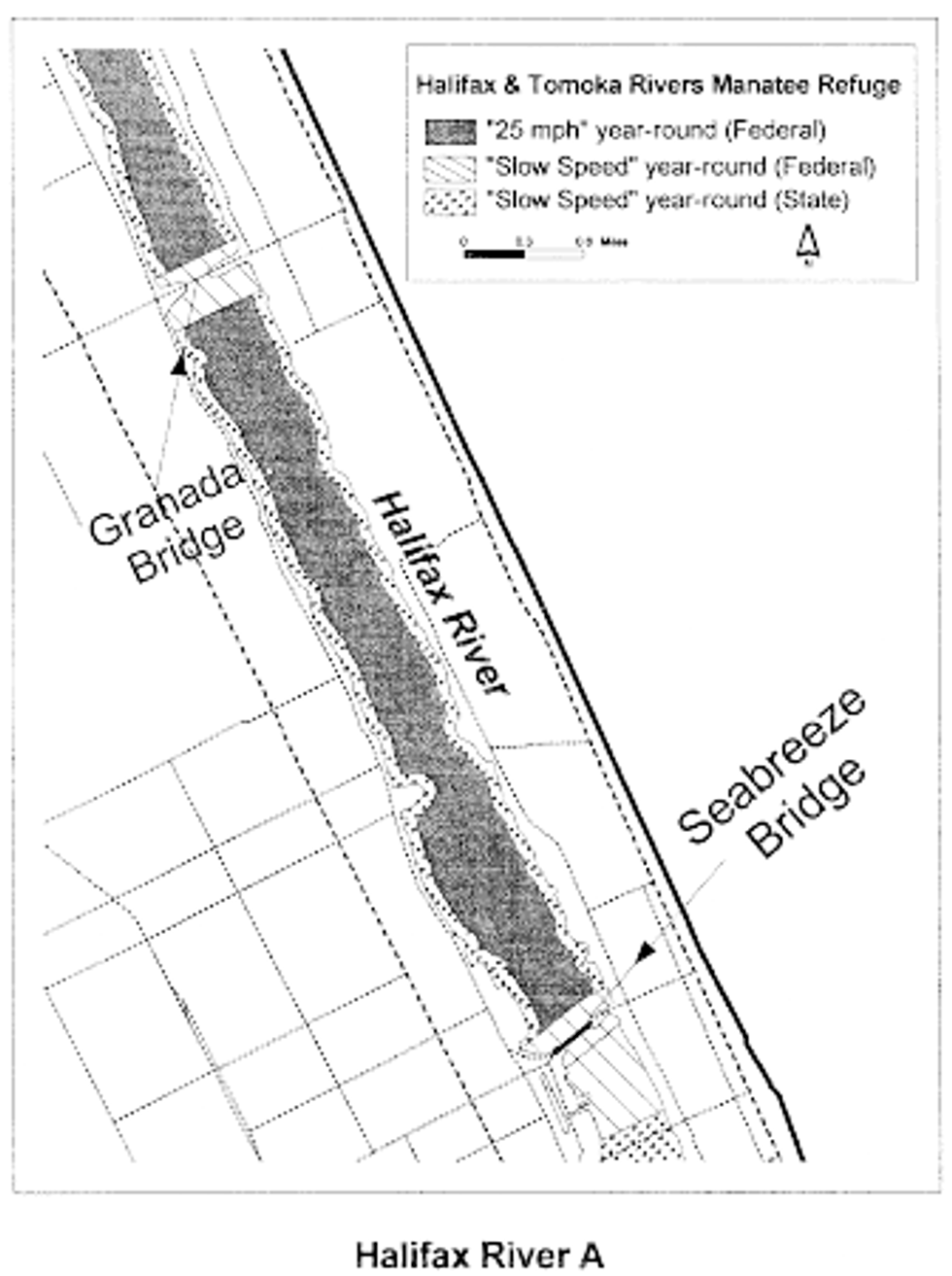
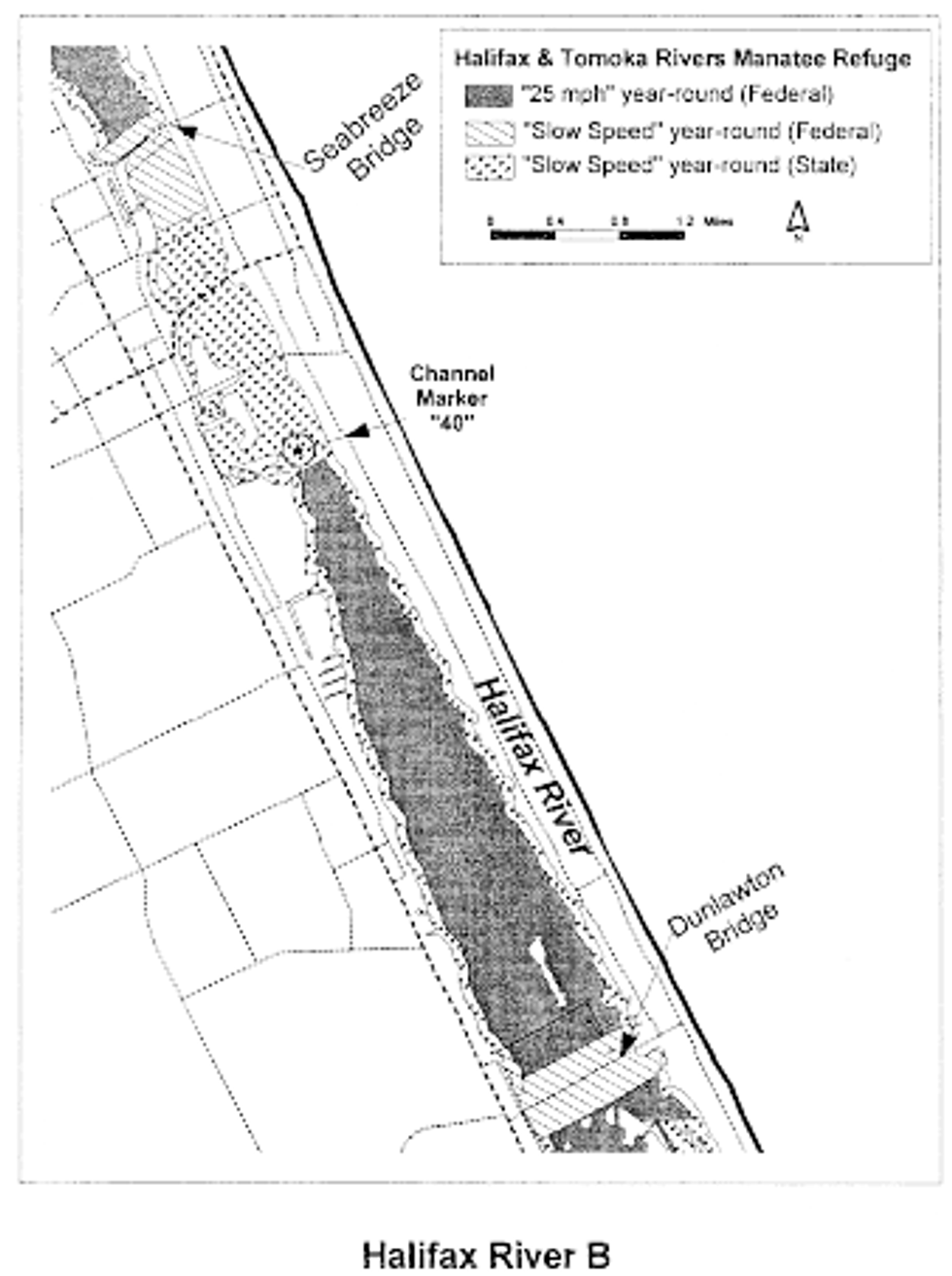

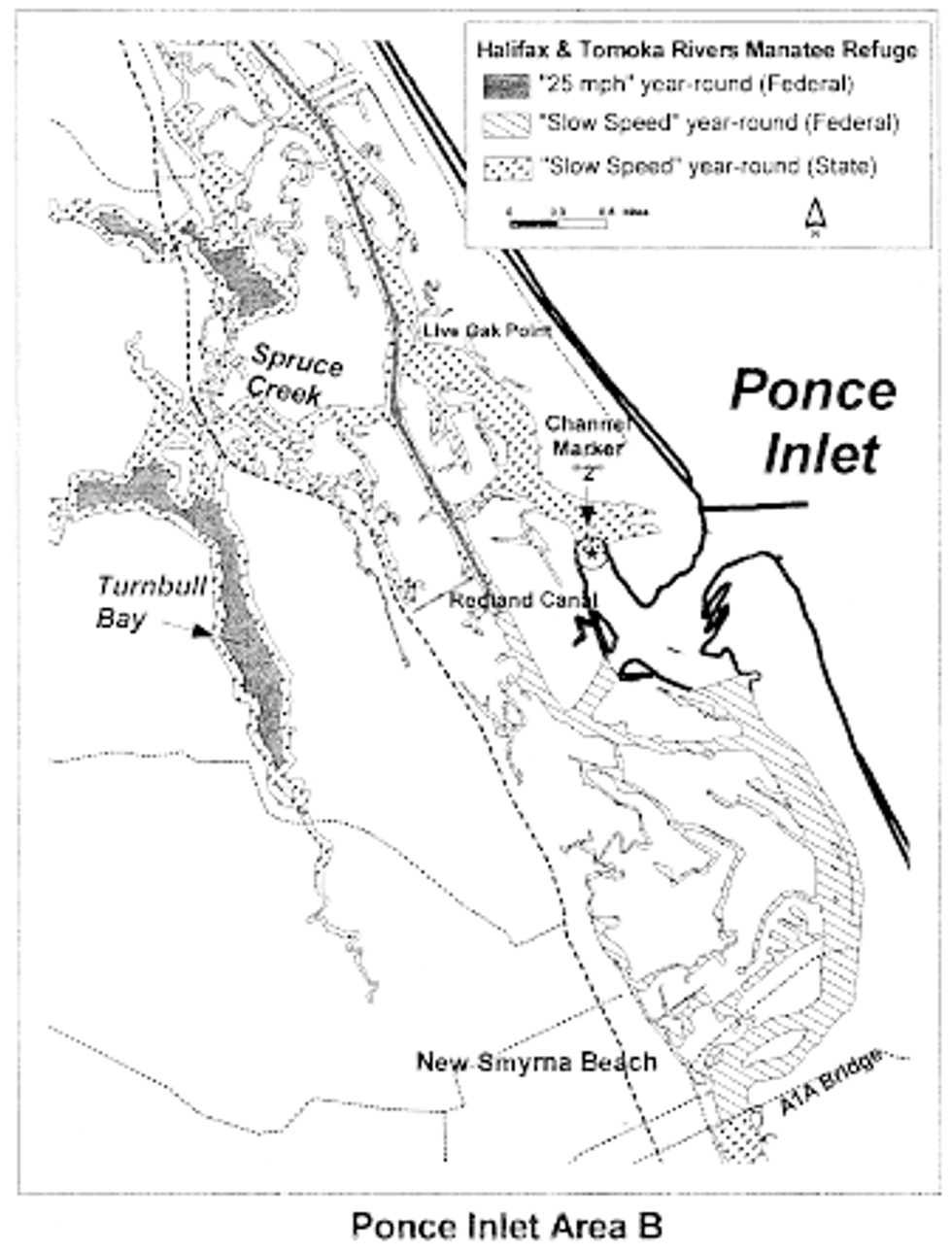
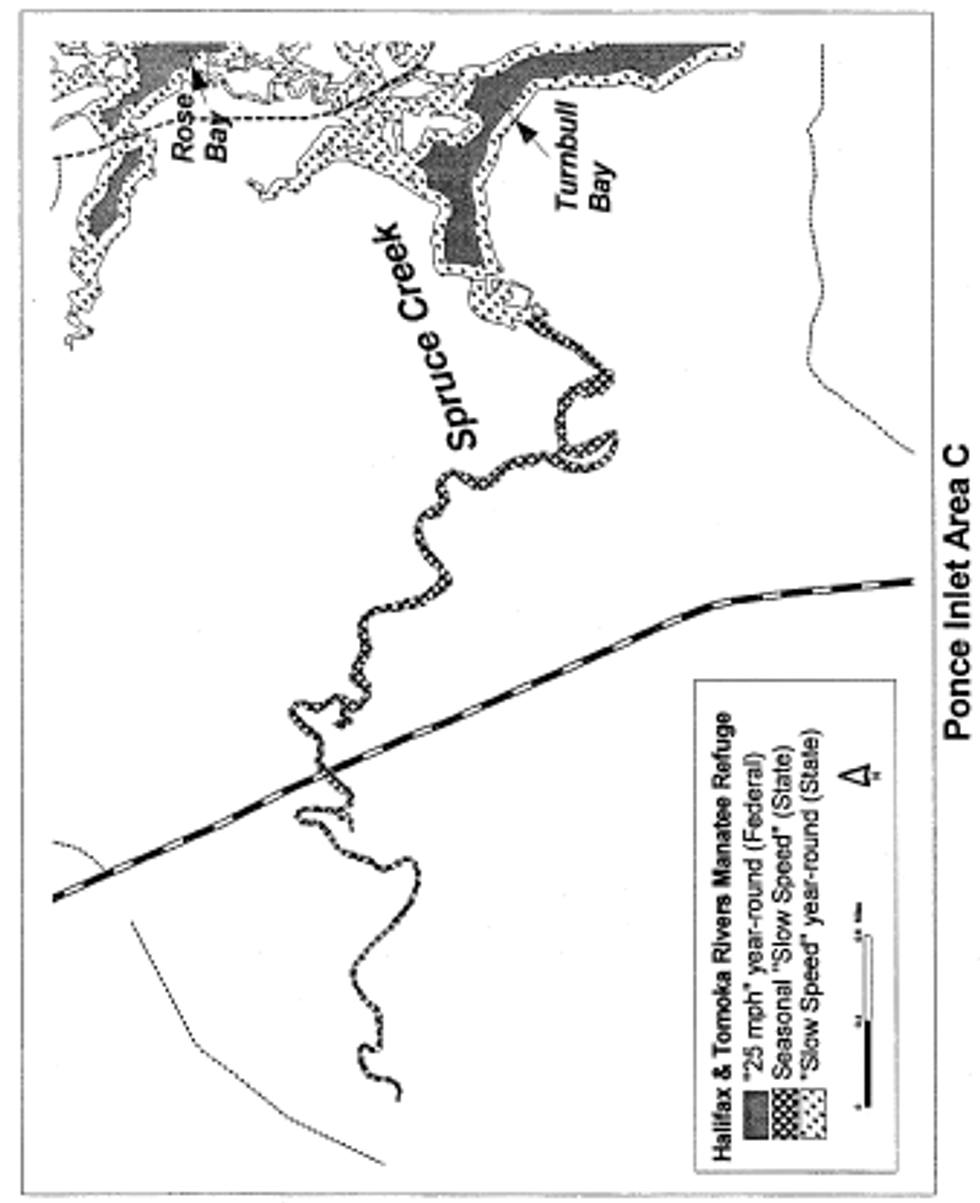
(13) The Pine Island-Estero Bay Manatee Refuge. (i) Watercraft are required to proceed at slow speed all year in all waters of Matlacha Pass, south of a line that bears 90� and 270� from Matlacha Pass Green Channel Marker 77 (approximate latitude 26�40?00? North, approximate longitude 82�06?00? West), and north of Pine Island Road (State Road 78), excluding:
(A) The portion of the marked channel otherwise designated in paragraph (c)(13)(iii) of this section;
(B) All waters of Buzzard Bay east and northeast of a line beginning at a point (approximate latitude 26�40?00? North, approximate longitude 82�05?20? West) on the southwest shoreline of an unnamed mangrove island east of Matlacha Pass Green Channel Marker 77 and bearing 219� to the northeasternmost point (approximate latitude 26�39?58? North, approximate longitude 82�05?23? West) of another unnamed mangrove island, then running along the eastern shoreline of said island to its southeasternmost point (approximate latitude 26�39?36? North, approximate longitude 82�05?09? West), then bearing 115� to the westernmost point (approximate latitude 26�39?34? North, approximate longitude 82�05?05? West) of the unnamed mangrove island to the southeast, then running along the western shoreline of said island to its southwesternmost point (approximate latitude 26�39?22? North, approximate longitude 82�04?53? West), then bearing 123� to the northwesternmost point (approximate latitude 26�39?21? North, approximate longitude 82�04?52? West) of an unnamed mangrove island, then running along the western shoreline of said island to its southeasternmost point (approximate latitude 26�39?09? North, approximate longitude 82�04?44? West), then bearing 103� to the northwesternmost point (approximate latitude 26�39?08? North, approximate longitude 82�04?41? West) of a peninsula on the unnamed mangrove island to the southeast, then running along the southwestern shoreline of said island to its southeasternmost point (approximate latitude 26�38?51? North, approximate longitude 82�04?18? West), then bearing 99� to the southernmost point (approximate latitude 26�38?50? North, approximate longitude 82�04?03? West) of the unnamed mangrove island to the east, then bearing 90� to the line's terminus at a point (approximate latitude 26�38?50? North, approximate longitude 82�03?55? West) on the eastern shoreline of Matlacha Pass; and
(C) All waters of Pine Island Creek and Matlacha Pass north of Pine Island Road (State Road 78) and west and southwest of a line beginning at a point (approximate latitude 26�39?29? North, approximate longitude 82�06?29? West) on the western shoreline of Matlacha Pass and bearing 160� to the westernmost point (approximate latitude 26�39?25? North, approximate longitude 82�06?28? West) of an unnamed island, then running along the western shoreline of said island to its southernmost point (approximate latitude 26�39?18? North, approximate longitude 82�06?24? West), then bearing 128� to the northernmost point (approximate latitude 26�39?12? North, approximate longitude 82�06?17? West) of an unnamed mangrove island to the south, then running along the eastern shoreline of said island to its southeasternmost point (approximate latitude 26�39?00? North, approximate longitude 82�06?09? West), then bearing 138� to a point (approximate latitude 26�38?45? North, approximate longitude 82�05?53? West) on the northern shoreline of Bear Key, then running along the northern shoreline of Bear Key to its easternmost point (approximate latitude 26�38?44? North, approximate longitude 82�05?46? West), then bearing 85� to the westernmost point (approximate latitude 26�38?45? North, approximate longitude 82�05?32? West) of Deer Key, then running along the northern shoreline of Deer Key to its easternmost point (approximate latitude 26�38?46? North, approximate longitude 82�05?22? West), then bearing 103� to the northwesternmost point (approximate latitude 26�38?45? North, approximate longitude 82�05?17? West) of the unnamed mangrove island to the east, then running along the western shoreline of said island to its southernmost point (approximate latitude 26�38?30? North, approximate longitude 82�05?04? West), then bearing 106� to the westernmost point (approximate latitude 26�38?30? North, approximate longitude 82�04?57? West) of the unnamed island to the southeast, then running along the northern and eastern shorelines of said island to a point (approximate latitude 26�38?23? North, approximate longitude 82�04?51? West) on its eastern shoreline, then bearing 113� to the northernmost point of West Island (approximate latitude 26�38?21? North, approximate longitude 82�04?37? West), then running along the western shoreline of West Island to the point where the line intersects Pine Island Road (State Road 78).
(ii) Watercraft are required to proceed at slow speed all year in all waters of Matlacha Pass, St. James Creek, and San Carlos Bay, south of Pine Island Road (State Road 78), north of a line 500 feet northwest of and parallel to the main marked channel of the Intracoastal Waterway, west of a line that bears 302� from Intracoastal Waterway Green Channel Marker 99 (approximate latitude 26�31?00? North, approximate longitude 82�00?52? West), and east of a line that bears 360� from Intracoastal Waterway Red Channel Marker 10 (approximate latitude 26�29?16? North, approximate longitude 82�03?35? West), excluding:
(A) The portions of the marked channels otherwise designated in paragraphs (c)(15)(iv) and (v) of this section;
(B) All waters of Matlacha Pass south of Pine Island Road (State Road 78) and west of the western shoreline of West Island and a line beginning at the southernmost point (approximate latitude 26�37?25? North, approximate longitude 82�04?17? West) of West Island and bearing 149� to the northernmost point (approximate latitude 26�37?18? North, approximate longitude 82�04?12? West) of the unnamed mangrove island to the south, then running along the eastern shoreline of said island to its southernmost point (approximate latitude 26�36?55? North, approximate longitude 82�04?02? West), then bearing 163� to the line's terminus at a point (approximate latitude 26�36?44? North, approximate longitude 82�03?58? West) on the eastern shoreline of Little Pine Island;
(C) All waters of Matlacha Pass, Pontoon Bay, and associated embayments south of Pine Island Road (State Road 78) and east of a line beginning at a point (approximate latitude 26�38?12? North, approximate longitude 82�03?46? West) on the northwestern shoreline of the embayment on the east side of Matlacha Pass, immediately south of Pine Island Road and then running along the eastern shoreline of the unnamed island to the south to its southeasternmost point (approximate latitude 26�37?30? North, approximate longitude 82�03?22? West), then bearing 163� to the northwesternmost point of the unnamed island to the south, then running along the western shoreline of said island to its southernmost point (approximate latitude 26�37?15? North, approximate longitude 82�03?15? West), then bearing 186� to the line's terminus at a point (approximate latitude 26�37?10? North, approximate longitude 82�03?16? West) on the eastern shoreline of Matlacha Pass;
(D) All waters of Pine Island Creek south of Pine Island Road (State Road 78); and all waters of Matlacha Pass, Rock Creek, and the Mud Hole, west of a line beginning at a point (approximate latitude 26�33?52? North, approximate longitude 82�04?53? West) on the western shoreline of Matlacha Pass and bearing 22� to a point (approximate latitude 26�34?09? North, approximate longitude 82�04?45? West) on the southern shoreline of the unnamed island to the northeast, then running along the southern and eastern shorelines of said island to a point (approximate latitude 26�34?15? North, approximate longitude 82�04?39? West) on its northeastern shoreline, then bearing 24� to a point (approximate latitude 26�34?21? North, approximate longitude 82�04?36? West) on the southern shoreline of the large unnamed island to the north, then running along the southern and eastern shorelines of said island to a point (approximate latitude 26�34?31? North, approximate longitude 82�04?29? West) on its eastern shoreline, then bearing 41� to the southernmost point (approximate latitude 26�34?39? North, approximate longitude 82�04?22? West) of another unnamed island to the northeast, then running along the eastern shoreline of said island to its northwesternmost point (approximate latitude 26�35?22? North, approximate longitude 82�04?07? West), then bearing 2� to the southernmost point (approximate latitude 26�35?32? North, approximate longitude 82�04?07? West) of the unnamed island to the north, then running along the eastern shoreline of said island to its northernmost point (approximate latitude 26�35?51? North, approximate longitude 82�03?59? West), then bearing 353� to the line's terminus at a point (approximate latitude 26�36?08? North, approximate longitude 82�04?01? West) on the eastern shoreline of Little Pine Island; and
(E) All waters of Punta Blanca Bay and Punta Blanca Creek, east of the eastern shoreline of Matlacha Pass and east and north of the eastern and northern shorelines of San Carlos Bay.
(iii) Watercraft may not exceed 25 miles per hour, all year, in all waters within the main marked channel in Matlacha Pass south of Green Channel Marker 77 (approximate latitude 26�40?00? North, approximate longitude 82�06?00? West) and north of a line perpendicular to the channel at a point in the channel 1/4 mile northwest of the Pine Island Road Bridge (State Road 78).
(iv) Watercraft may not exceed 25 miles per hour, all year, in all waters within the main marked channel in Matlacha Pass south of a line perpendicular to the channel at a point in the channel 1/4 mile southeast of the Pine Island Road Bridge (State Road 78), and north of a line 500 feet northwest of and parallel to the main marked channel of the Intracoastal Waterway (just north of Green Channel Marker 1).
(v) Watercraft may not exceed 25 miles per hour, all year, in all waters within the marked channel in Matlacha Pass that intersects the main Matlacha Pass channel near Green Channel Marker 15 (approximate latitude 26�31?57? North, approximate longitude 82�03?38? West) and intersects the main marked channel of the Intracoastal Waterway near Green Channel Marker 101 (approximate latitude 26�30?39? North, approximate longitude 82�01?00? West).
(vi) Watercraft are required to proceed at slow speed from April 1 through November 15 in all canals and boat basins of St. James City and the waters known as Long Cut and Short Cut; and all waters of Pine Island Sound and San Carlos Bay south of a line beginning at the southernmost tip (approximate latitude 26�31?28? North, approximate longitude 82�06?19? West) of a mangrove peninsula on the western shore of Pine Island approximately 2200 feet north of Galt Island and bearing 309� to the southeasternmost point (approximate latitude 26�31?32? North, approximate longitude 82�06?25? West) of another mangrove peninsula, then running along the southern shoreline of said peninsula to its southwesternmost point (approximate latitude 26�31?40? North, approximate longitude 82�06?38? West), then bearing 248� to a point (approximate latitude 26�31?40? North, approximate longitude 82�06?39? West) on the eastern shoreline of an unnamed mangrove island, then running along the southern shoreline of said island to its southwesternmost point (approximate latitude 26�31?39? North, approximate longitude 82�06?44? West), then bearing 206� to the line's terminus at the northernmost point of the Mac Keever Keys (approximate latitude 26�31?09? North, approximate longitude 82�07?09? West), east of a line beginning at said northernmost point of the Mac Keever Keys and running along and between the general contour of the western shorelines of said keys to a point (approximate latitude 26�30?27? North, approximate longitude 82�07?08? West) on the southernmost of the Mac Keever Keys, then bearing 201� to a point (approximate latitude 26�30?01? North, approximate longitude 82�07?19? West) approximately 150 feet due east of the southeasternmost point of Chino Island, then bearing approximately 162� to Red Intracoastal Waterway Channel Marker 22 (approximate latitude 26�28?57? North, approximate longitude 82�06?55? West), then bearing approximately 117� to the line's terminus at Red Intracoastal Waterway Channel Marker 20 (approximate latitude 26�28?45? North, approximate longitude 82�06?38? West), north of a line beginning at said Red Intracoastal Waterway Channel Marker 20 and bearing 86� to a point (approximate latitude 26�28?50? North, approximate longitude 82�05?48? West) 1/4 mile south of York Island, then running parallel to and 1/4 mile south of the general contour of the southern shorelines of York Island and Pine Island to the line's terminus at a point on a line bearing 360� from Red Intracoastal Waterway Channel Marker 10 (approximate latitude 26�29?16? North, approximate longitude 82�03?35? West), and west and southwest of the general contour of the western and southern shorelines of Pine Island and a line that bears 360� from said Red Intracoastal Waterway Channel Marker 10, excluding the portion of the marked channel otherwise designated in paragraph (c)(13)(vii) of this section.
(vii) Watercraft may not exceed 25 miles per hour from April 1 through November 15 in all waters of the marked channel that runs north of the power lines from the Cherry Estates area of St. James City into Pine Island Sound, east of the western boundary of the zone designated in 17.108(c)(13)(vi), and west of a line perpendicular to the power lines that begins at the easternmost point (approximate latitude 26�30?25? North, approximate longitude 82�06?15? West) of the mangrove island on the north side of the power lines approximately 1,800 feet southwest of the Galt Island Causeway.
(viii) Watercraft are required to proceed at slow speed all year in all waters of San Carlos Bay and Punta Rassa Cove east of a line that bears 352� from the northernmost tip of the northern peninsula on Punta Rassa (approximate latitude 26�29?44? North, approximate longitude 82�00?33? West), and south of a line that bears 122� from Intracoastal Waterway Green Channel Marker 99 (approximate latitude 26�31?00? North, approximate longitude 82�00?52? West), including all waters of Shell Creek and associated waterways.
(ix) Watercraft are required to proceed at slow speed all year in all waters of San Carlos Bay and the Caloosahatchee River, including the residential canals of Cape Coral, northeast of a line that bears 302� and 122� from Intracoastal Waterway Green Channel Marker 99 (approximate latitude 26�31?00? North, approximate longitude 82�00?52? West), west of a line that bears 346� from Intracoastal Waterway Green Channel Marker 93 (approximate latitude 26�31?37? North, approximate longitude 81�59?46? West), and north and northwest of the general contour of the northwestern shoreline of Shell Point and a line that bears approximately 74� from the northernmost tip (approximate latitude 26�31?31? North, approximate longitude 81�59?57? West) of Shell Point to said Intracoastal Waterway Green Channel Marker 93, excluding the Intracoastal Waterway between markers 93 and 99 (which is already designated as a Federal manatee protection area, requiring watercraft to proceed at slow speed, and is not impacted by this rule).
(x) Watercraft are required to proceed at slow speed from April 1 through November 15 and at not more than 25 miles per hour the remainder of the year in all waters of Hell Peckney Bay southeast of Hurricane Bay, northeast of the northern shorelines of Julies Island and the unnamed island immediately northwest of Julies Island and a line that bears 312� from the northwesternmost point of Julies Island (approximate latitude 26�26?37? North, approximate longitude 81�54?57? West), northwest of Estero Bay, and southwest of a line beginning at the southernmost point (approximate latitude 26�27?23? North, approximate longitude 81�55?11? West) of an unnamed mangrove peninsula in northwest Hell Peckney Bay and bearing 191� to the northernmost point (approximate latitude 26�27?19? North, approximate longitude 81�55?11? West) of an unnamed mangrove island, then running along the northern shoreline of said island to its southeasternmost point (approximate latitude 26�27?11? North, approximate longitude 81�55?05? West), then bearing 115� to a point (approximate latitude 26�27?03? North, approximate longitude 81�54?47? West) on the northwest shoreline of an unnamed mangrove island, then running along the northern shoreline of said island to its northeasternmost point (approximate latitude 26�27?02? North, approximate longitude 81�54?33? West), and then bearing 37� to the line's terminus at the westernmost point of an unnamed mangrove peninsula in eastern Hell Peckney Bay.
(xi) Watercraft are required to proceed at slow speed from April 1 through November 15 and at not more than 25 miles per hour the remainder of the year in all waters of Hendry Creek south of a line that bears 270� from a point (approximate latitude 26�28?40? North, approximate longitude 81�52?56? West) on the eastern shoreline of Hendry Creek; and all waters of Estero Bay southeast and east of Hell Peckney Bay, a line that bears 340� from a point (approximate latitude 26�25?56? North, approximate longitude 81�54?25? West) on the northern tip of an unnamed mangrove peninsula on the northeastern shoreline of Estero Island, and the northern shoreline of Estero Island, south of Hendry Creek and a line that bears 135� and 315� from Red Channel Marker 18 (approximate latitude 26�27?46? North, approximate longitude 81�52?00? West) in Mullock Creek, and north of a line that bears 72� from the northernmost point (approximate latitude 26�24?22? North, approximate longitude 81�52?34? West) of Black Island, including the waters of Buccaneer Lagoon at the southern end of Estero Island, but excluding:
(A) The portions of the marked channels otherwise designated in paragraph (c)(13)(xiii) of this section;
(B) The Estero River; and
(C) To waters of Big Carlos Pass east of a line beginning at a point (approximate latitude 26�24?34? North, approximate longitude 81�53?05? West) on the eastern shoreline of Estero Island and bearing 36� to a point (approximate latitude 26�24?40? North, approximate longitude 81�53?00? West) on the southern shoreline of Coon Key, south of a line beginning at a point (approximate latitude 26�24?36? North, approximate longitude 81�52?30? West) on the eastern shoreline of Coon Key and bearing 106� to a point (approximate latitude 26�24?39? North, approximate longitude 81�52?34? West) on the southwestern shoreline of the unnamed mangrove island north of Black Island, and west of a line beginning at a point (approximate latitude 26�24?36? North, approximate longitude 81�52?30? West) on the southern shoreline of said unnamed mangrove island north of Black Island and bearing 192� to the northernmost point (approximate latitude 26�24?22? North, approximate longitude 81�52?34? West) of Black Island.
(xii) Watercraft are required to proceed at slow speed from April 1 through November 15 and at not more than 25 miles per hour the remainder of the year in all waters of Estero Bay and Big Hickory Bay south of a line that bears 72� from the northernmost point (approximate latitude 26�24?22? North, approximate longitude 81�52?34? West) of Black Island, east of the centerline of State Road 865 (but including the waters of the embayment on the eastern side of Black Island and the waters inshore of the mouth of Big Hickory Pass that are west of State Road 865), and north of a line that bears 90� from a point (approximate latitude 26�20?51? North, approximate longitude 81�50?33? West) on the eastern shoreline of Little Hickory Island, excluding Spring Creek and the portions of the marked channels otherwise designated under 17.108(c)(13)(xiii) and the portion of Hickory Bay designated in paragraph (c)(13)(xiii) of this section.
(xiii) Watercraft may not exceed 25 miles per hour all year in:
(A) All waters of Big Hickory Bay north of a line that bears 90� from a point (approximate latitude 26�20?51� North, approximate longitude 81�50?33? West) on the eastern shoreline of Little Hickory Island, west of a line beginning at a point (approximate latitude 26�20?48? North, approximate longitude 81�50?24? West) on the southern shoreline of Big Hickory Bay and bearing 338� to a point (approximate latitude 26�21?39? North, approximate longitude 81�50?48? West) on the water in the northwestern end of Big Hickory Bay near the eastern end of Broadway Channel, south of a line beginning at said point on the water in the northwestern end of Big Hickory Bay and bearing 242� to the northernmost point (approximate latitude 26�21?39? North, approximate longitude 81�50?50? West) of the unnamed mangrove island south of Broadway Channel, and east of the eastern shoreline of said mangrove island and a line beginning at the southernmost point of said island (approximate latitude 26�21?07? North, approximate longitude 81�50?58? West) and bearing 167� to a point on Little Hickory Island (approximate latitude 26�21?03? North, approximate longitude 81�50?57? West);
(B) All waters of the main marked North-South channel in northern Estero Bay from Green Channel Marker 37 (approximate latitude 26�26?02 North, approximate longitude 81�54?29? West) to Green Channel Marker 57 (approximate latitude 26�25?08? North, approximate longitude 81�53?29? West);
(C) All waters of the main marked North-South channel in southern Estero Bay south of a line beginning at a point (approximate latitude 26�24?36? North, approximate longitude 81�52?30? West) on the southern shoreline of the unnamed mangrove island north of Black Island and bearing 192� to the northernmost point (approximate latitude 26�24?22? North, approximate longitude 81�52?34? West) of Black Island, and north and east of Red Channel Marker 62 (approximate latitude 26�21?31? North, approximate longitude 81�51?20? West) in Broadway Channel;
(D) All waters within the portion of the marked channel leading to the Gulf of Mexico through New Pass, west of the North-South channel and east of State Road 865; all waters of the marked channel leading to Mullock Creek north of a line beginning at a point (approximate latitude 26�24?36? North, approximate longitude 81�52?30? West) on the eastern shoreline of Coon Key and bearing 106� to a point (approximate latitude 26�24?39? North, approximate longitude 81�52?34? West) on the southwestern shoreline of the unnamed mangrove island north of Black Island, and south of Red Channel Marker 18 (approximate latitude 26�27?46? North, approximate longitude 81�52?00? West);
(E) All waters of the marked channel leading from the Mullock Creek Channel to the Estero River, west of the mouth of the Estero River. (This designation only applies if a channel is marked in accordance with permits issued by all applicable State and federal authorities. In the absence of a properly permitted channel, this area is as designated under paragraph (c)(13)(xi) of this section);
(F) All waters of the marked channel commonly known as Alternate Route Channel, with said channel generally running between Channel Marker 1 (approximate latitude 26�24?29? North, approximate longitude 81�51?53? West) and Channel Marker 10 (approximate latitude 26�24?00? North, approximate longitude 81�51?09? West);
(G) All waters of the marked channel commonly known as Coconut Channel, with said channel generally running between Channel Marker 1 (approximate latitude 26�23?44? North, approximate longitude 81�50?55? West) and Channel Marker 23 (approximate latitude 26�24?00? North, approximate longitude 81�50?30? West);
(H) All waters of the marked channel commonly known as Southern Passage Channel, with said channel generally running between Channel Marker 1 (approximate latitude 26�22?58? North, approximate longitude 81�51?57? West) and Channel Marker 22 (approximate latitude 26�23?27? North, approximate longitude 81�50?46? West); and
(I) All waters of the marked channel leading from the Southern Passage Channel to Spring Creek, west of the mouth of Spring Creek.
(xiv) Maps of the Pine Island-Estero Bay Manatee Refuge follow:
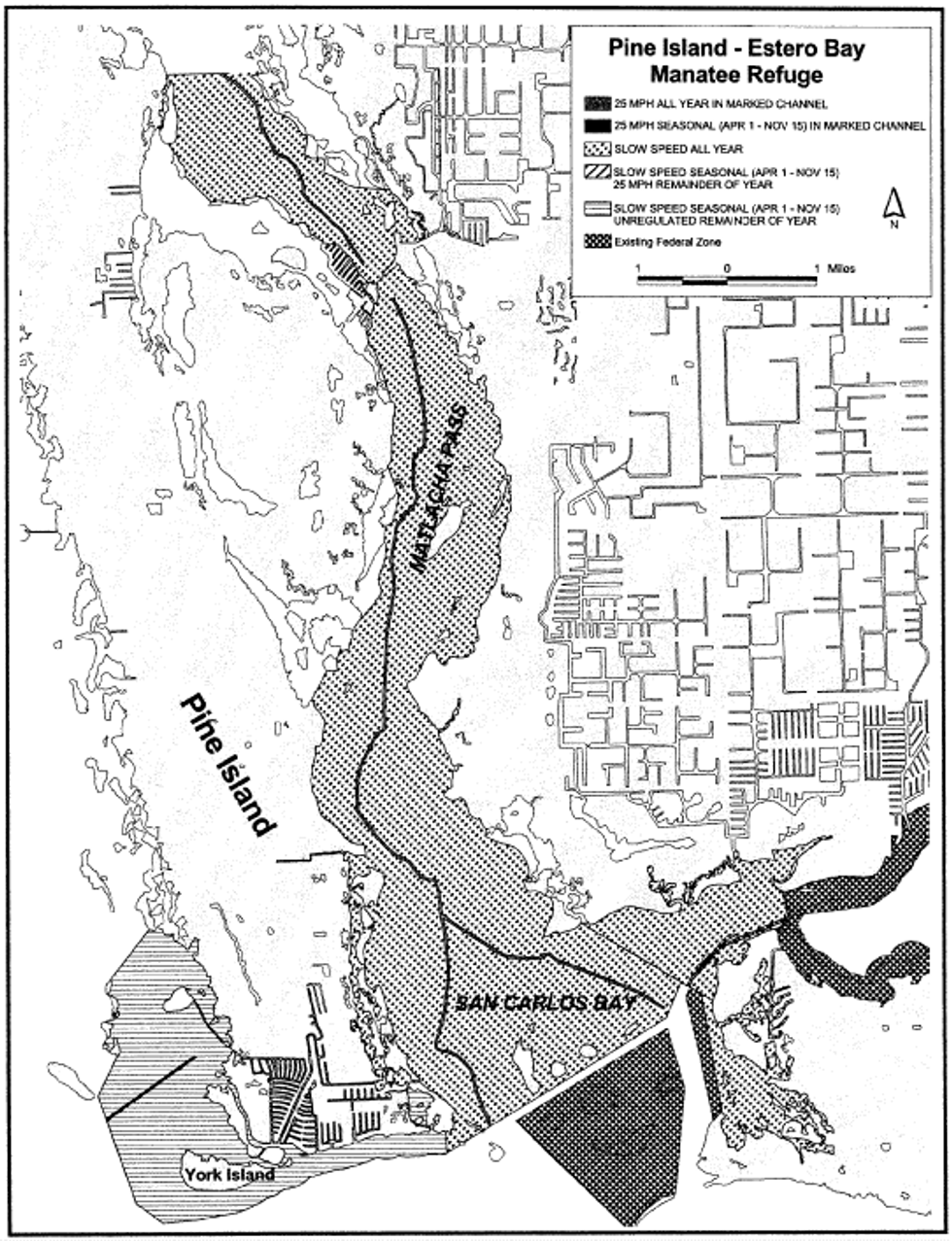

(14) The Kings Bay Manatee Refuge. A tract of submerged land that includes all waters of Kings Bay, including all tributaries and adjoining waterbodies, upstream of the confluence of Kings Bay and Crystal River, described by a line that bears North 53�00?00? East (True) from the northeasternmost point of an island on the southwesterly shore of Crystal River (approximate latitude 28�53?32? North, approximate longitude 82�36?23? West) to the southwesternmost point of a peninsula of Magnolia Shores (approximate latitude 28�53?38? North, approximate longitude 82�36?16? West).
(i) Area covered. The Kings Bay Manatee Refuge encompasses existing manatee protection areas as described in paragraphs (a)(1) through (a)(7) of this section, and areas outside these sections as depicted on the map in paragraph (c)(14)(ii) of this section.
(ii) Particular areas. The following springs fall within the boundaries of the Kings Bay Manatee Refuge. A map showing the entire refuge, including these springs, follows:
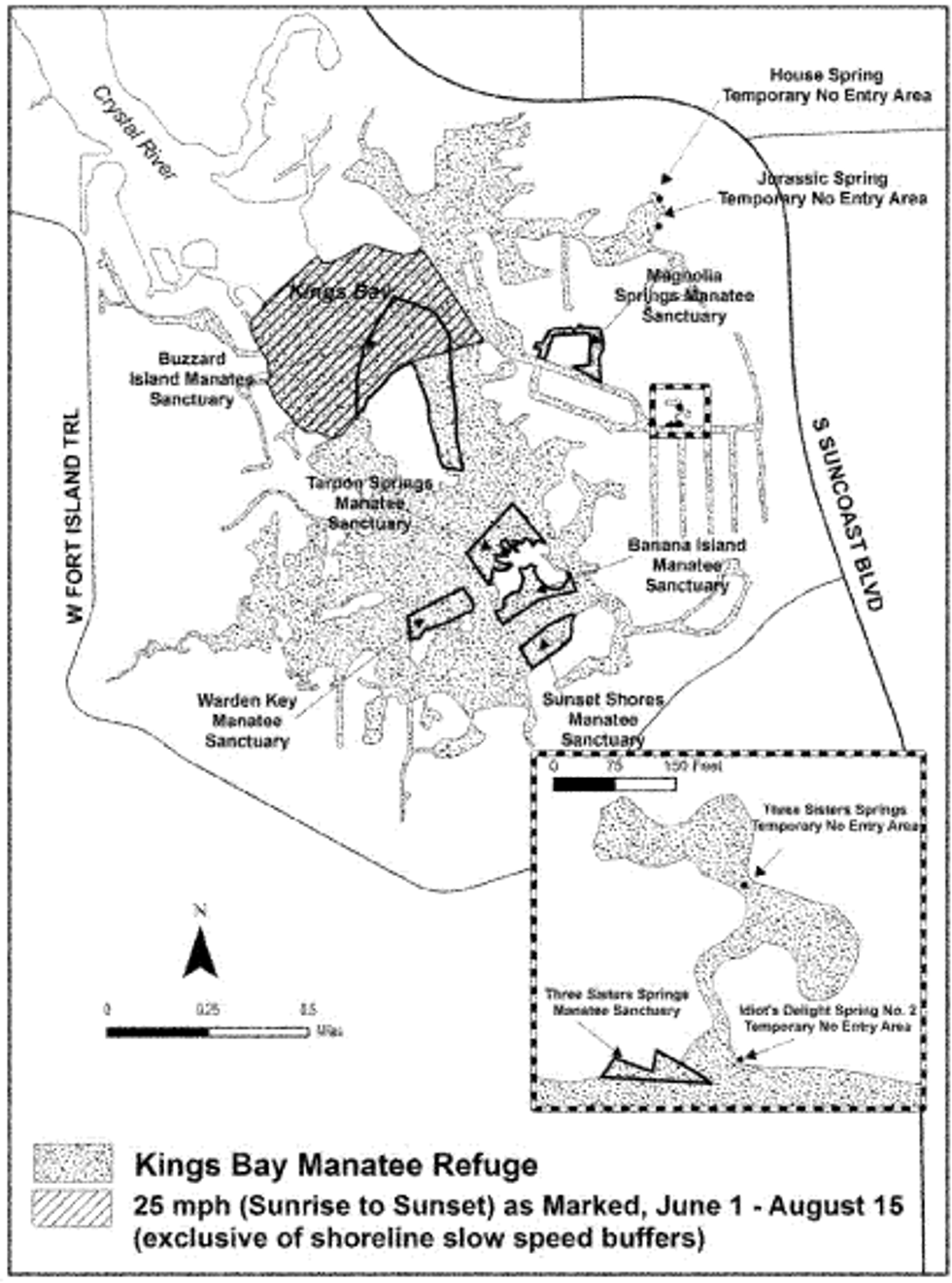
(A) Three Sisters Springs. A tract of submerged land, lying in Section 28, Township 18 South, Range 17 East, Tallahassee Meridian, Citrus County, Florida, more particularly described as follows: For a point of reference, commence at the northwest corner of said Section 28 in an east southeast direction to the canal that begins on the west side of Southeast Cutler Spur Boulevard and runs west-northwest to Kings Bay. The spring is north and east of the northern terminus of Southeast Paradise Avenue along the northern shore of said canal. Three Sisters Springs includes three main and numerous smaller spring vents and a spring run that connects the vents to said canal in Crystal River, Citrus County, Florida. This area is not the same as set forth in paragraph (a)(7) of this section. This area is behind the sanctuary (north from the mouth of the channel) as set forth in paragraph (a)(7) of this section.
(1) All waterborne activities in this specific area are prohibited from sunset to sunrise from November 15 through March 31 exclusive of the provisions of paragraph (c)(14)(v) of this section.
(2) Scuba diving and fishing (including but not limited to fishing by hook and line, by cast net, and by spear) are also prohibited in this specific area from November 15 through March 31 exclusive of the provisions of paragraph (c)(14)(v) of this section.
(3) If the provisions of paragraph (c)(14)(vi) of this section are put in effect, all waterborne activities are prohibited in this specific area for the duration established under paragraph (c)(14)(vi) of this section.
(B) House Spring. A tract of submerged land, lying in Section 21, Township 18 South, Range 17 East, Tallahassee Meridian, Citrus County, Florida, more particularly described as follows: For a point of reference, commence at the southwest corner of said Section 21 in an east-northeast direction to the northeasternmost corner of Hunter Spring Run. The spring is immediately west of and adjacent to Northeast 2nd Court in Crystal River, Citrus County, Florida.
(C) Jurassic Spring. A tract of submerged land, lying in Section 21, Township 18 South, Range 17 East, Tallahassee Meridian, Citrus County, Florida, more particularly described as follows: For a point of reference, commence at the southwest corner of said Section 21 in an east northeast direction to the eastern shore of Hunter Spring Run. The spring is immediately west of the western terminus of Bayshore Drive in Crystal River, Citrus County, Florida.
(D) Idiot's Delight Number 2 Spring. A tract of submerged land, lying in Section 28, Township 18 South, Range 17 East, Tallahassee Meridian, Citrus County, Florida, more particularly described as follows: For a point of reference, commence at the northwest corner of said Section 28 in an east southeast direction to the canal that begins on the west side of Southeast Cutler Spur Boulevard and runs west-northwest to Kings Bay. The spring is north and east of the northern terminus of Southeast Paradise Avenue along the northern shore of said canal just east of the southern terminus of the Three Sisters Springs run in Crystal River, Citrus County, Florida.
(iii) Speed and anchoring restrictions. (A) Throughout the entire year, watercraft speeds are restricted to slow speed throughout the manatee refuge with the following exceptions:
(1) A posted area generally north of Buzzard Island, exclusive of shoreline slow-speed buffer zones, where watercraft may travel at speeds up to 25 miles per hour during daylight hours (sunrise to sunset) from June 1 through August 15;
(2) Those areas where access is precluded (manatee sanctuaries, no-entry areas); or
(3) Areas where more restrictive speed restrictions are in effect.
(B) From June 1 through August 15, anchorage (other than emergency anchorage) of watercraft is prohibited in the posted high speed (25 miles per hour) area around Buzzard Island referenced in paragraph (c)(14)(iii)(A) of this section.
(iv) Time and area prohibitions. When the provisions of paragraphs (c)(14)(v) or (vi) of this section are in effect (November 15 through March 31 and April 1 through November 14, respectively), all waterborne activities, including swimming, diving (including skin and scuba diving), snorkeling, water skiing, surfing, fishing (including with hook and line, by cast net, or spear), and the use of water vehicles (including but not limited to boats powered by engine, wind, or other means; ships powered by engine, wind, or other means; barges, surfboards, personal watercraft, water skis, and any other devices or mechanisms capable of locomotion on, across, or underneath the surface of the water) are prohibited in areas that are adjacent to and within specified distances from the existing manatee sanctuaries located in Kings Bay (defined in paragraphs (a)(1) through (a)(7) of this section) and the springs defined in paragraph (c)(14)(ii) of this section: Three Sisters Springs, House Spring, Jurassic Spring, and Idiot's Delight Number 2 Spring.
(v) Expanded temporary no-entry area (November 15 through March 31). When manatees exceed the capacity of an existing manatee sanctuary or shift usage around an existing manatee sanctuary or shift usage to Three Sisters Springs, House Spring, Jurassic Spring, and Idiot's Delight Number 2 Spring, due to water or weather or other conditions, we will designate �no-entry� areas from November 15 through March 31 as appropriate and necessary around any of these sites. The determination to designate and subsequently remove no-entry areas around existing manatee sanctuaries and Three Sisters Springs, House Spring, Jurassic Spring, and Idiot's Delight Number 2 Spring within the Kings Bay Manatee Refuge will be based on aerial survey observations of manatees using the existing sanctuary sites, current weather information, and other sources of credible, relevant information. We will designate no-entry areas within Kings Bay Manatee Refuge and outside of existing sanctuaries as follows:
(A) For the sanctuaries set forth in paragraphs (a)(1) through (a)(6) of this section, to a distance not to exceed 100 feet from the existing sanctuary boundary.
(B) For the Three Sisters Springs Sanctuary, to a distance not to exceed 400 feet from the existing boundary. We do not intend to completely mark off the manmade channel. Expansions could occur directly around the existing sanctuary and north into the area locally known as Three Sisters Springs.
(C) For House Spring and Jurassic Spring, an area that does not exceed 100 feet from the associated spring vents.
(D) For Idiot's Delight Number 2 Spring, an area that does not exceed 25 feet from the associated spring vent. Any temporary designation will be configured to avoid the manmade channel in the canal and will not block access into Three Sisters Springs.
(vi) Temporary no-entry areas (April 1 through November 14). Temporary no-entry area designations may be made in the existing manatee sanctuaries located in Kings Bay defined in paragraphs (a)(1) through (a)(7) and paragraphs (c)(14)(v)(A) through (D) of this section prior to November 15 and after March 31 during cold fronts when manatees are present. Designations will remain in effect for the duration of a cold front and only when there is regular manatee use; temporary no-entry area designations will remain in effect for no longer than 14 consecutive days.
(vii) Posting of temporary no-entry areas designated in accordance with paragraph (c)(14)(v) or (vi) of this section. Additional temporary protection areas will be posted to distances as described in paragraph (c)(14)(v) of this section and identified by the following devices: buoys, float lines, signs, advisories from onsite Service employees and their designees, or other methods.
(viii) Notifications of temporary no-entry areas designated in accordance with paragraph (c)(14)(v) or (vi) of this section. When we determine that the provisions of paragraph (c)(14)(v) or (vi) of this section are appropriate, the temporary protection areas will be designated and posted to distances as described in paragraph (c)(14)(v) of this section. No-entry area designations will occur immediately. We will advise the public of designations through public notice(s) announcing and describing the measures in a local newspaper and other media, including but not limited to, local television and radio broadcasts, Web sites and other news outlets, as soon as time permits. Onsite Service employees and their designees, when present, may also inform waterway users of designations.
(ix) Prohibited activities (year-round). We specifically identify and prohibit the activities set forth in this paragraph to prevent the take of one or more manatees by individuals engaged in waterborne activities while in the water, in boats, or on-shore within the Kings Bay Manatee Refuge. In regard to these prohibited activities, we consider a resting manatee to be a mostly motionless manatee that rises to breathe from the water bottom, in the water column, or on the water's surface. While resting, a manatee may make minor changes in its posture and may slightly shift its position. Minor changes in posture occur when resting manatees breathe or roll. Resting manatees may also make slight movements with their flippers or tail to compensate for drift, etc. Prohibited activities include:
(A) Chasing or pursuing manatee(s).
(B) Disturbing or touching a resting or feeding manatee(s).
(C) Diving from the surface on to a resting or feeding manatee(s).
(D) Cornering or surrounding or attempting to corner or surround a manatee(s).
(E) Riding, holding, grabbing, or pinching or attempting to ride, hold, grab, or pinch a manatee(s).
(F) Poking, prodding, or stabbing or attempting to poke, prod, or stab a manatee(s) with anything, including your hands and feet.
(G) Standing on or attempting to stand on manatee(s).
(H) Separating a mother and calf or attempting to separate a mother and calf.
(I) Separating manatee(s) from a group or attempting to separate manatee(s) from a group.
(J) Giving manatee(s) anything to eat or drink or attempting to give manatee(s) anything to eat or drink.
(K) Actively initiating contact with belted or tagged manatee(s) and associated gear, including any belts, harnesses, tracking devices, or antennae.
(L) Interfering with rescue and research activities.
[45 FR 74881, Nov. 12, 1980, as amended at 57 FR 5990, Feb. 19, 1992; 59 FR 24658, May 12, 1994; 63 FR 55556, Oct. 16, 1998; 67 FR 693, Jan. 7, 2002; 67 FR 66473, Nov. 8, 2002; 68 FR 46898, Aug. 6, 2003; 69 FR 40805, July 7, 2004; 70 FR 17874, Apr. 7, 2005; 70 FR 21969, Apr. 28, 2005; 70 FR 29458, May 23, 2005; 77 FR 15631, Mar. 16, 2012]
['Species Protection']
['Endangered Species']
UPGRADE TO CONTINUE READING
Load More
J. J. Keller is the trusted source for DOT / Transportation, OSHA / Workplace Safety, Human Resources, Construction Safety and Hazmat / Hazardous Materials regulation compliance products and services. J. J. Keller helps you increase safety awareness, reduce risk, follow best practices, improve safety training, and stay current with changing regulations.
Copyright 2025 J. J. Keller & Associate, Inc. For re-use options please contact copyright@jjkeller.com or call 800-558-5011.
